——— M ———
M – (1) Mid. The mid component of an Mid-Side (M-S) stereo signal. (2) Momentary loudness. (3) Abbreviation for male. (4) Abbreviation for Mega, as in Mb for megabyte..
m – abbreviation for milli, as mm for millimeter.
.m4a – file extension for the AAC format and the MP4 format.
M7 capsule – the capsule developed by Neumann originally used in the Neumann U 47 microphone, introduced in 1947. The M7 capsule had the brass backplate covered with a thin metallized PVC diaphragm. Because the PVC suffered from early deterioration, Neumann replaced it in 1958 with a new capsule designated as the K47, which used a metallized polyester diaphragm. The K47 capsule shared a single backplate, which meant that both diaphragms had to tuned identically to produce balanced figure-8 or omni patterns. See also K67 capsule.
mA – milliAmpere.
Mac – short for MacIntosh.
MACE – Macintosh Audio Compression/Expansion.
MACE3 – see Macintosh Audio Compression/Expansion.
MACE6 – see Macintosh Audio Compression/Expansion.
MAC address – Media Access Control address.
MAC header – see Ethernet header.
machine control – a standard method for controlling and synchronizing audio and video machines using a 9-pin D-Sub connector via software and other protocols. A DAW can control or be controlled by an external transport, such an audio tape reorder (ATR) or a video tape recorder (VTR).
Macintosh – the trademark or brand name used by Apple for a family of personal computers introduced in 1984. Often called Mac for short.
Macintosh Audio Compression/Expansion (MACE) – a proprietary, lossy compression scheme developed by Apple for use on Macintosh computers. The sound quality is relatively poor. It works only on 8-bit digital AACaudio files, and supports only two compression ratios: 3:1 (MACE3 at 235 kbps) and 6:1 ( MACE6 at 117 kbps).
Macintosh operating systems – the operating systems (OS) developed by Apple, Inc. for use on its Macintosh series of personal computers. The first OS was introduced in 1984, and is now referred to as the “Classic” Mac OS. In 1996 the operating system was rebranded as Mac OS. The current Mac operating system was introduced in 2001 as Mac OS X. In 2012 it became simply OS X until 2016 when it was designated macOS. The current macOS is the basis of Apple's operating systems for its other devices, such as iOS, iPadOS, watchOS, and tvOS.
Mackie Designs, Inc. – see LOUD Technologies, Inc.
macOS – see Macintosh operating systems.
Mac OS – see Macintosh operating systems.
Mac OS X – see Macintosh operating systems.
Macromedia – a graphics, multimedia, and web development software company headquartered in San Francisco, California. Macromedia was created in 1992 with the merger of Authorware Inc. and MacroMind-Paracomp. It produced products such as Flash and Dreamweaver. It was acquired by Adobe in 2005.
MADI – Multichannel Audio Digital Interface. A professional multichannel version of the AES3 (AES/EBU) standard that allows transmitting up to 56 channels of digital audio data over a single coaxial cable terminated with BNC connectors, plus a second cable for word clock. MADI is also available in an optical version.
MAF – (1) Minimum Audible Frequency. (2) Minimum Audible Field.
MAGIX AG – a company based in Berlin, Germany, that provides software, online services, and digital content for creating, editing, managing, and presenting photos, graphics, videos, and music.
mag – short for magnetic film.
mag dubber – see sound follower.
magnet – a piece of iron, iron ore, alloy, or other material that has its constituent atoms aligned in such a way that the material exhibits properties of magnetism, that is, it attracts other iron-containing objects or it aligns itself in external magnetic fields.
magnetic – (1) Exerting a magnetic field. (2) Capable of being magnetized. (3) A descriptive term for material that can be magnetized and used to hold an audio signal, such as magnetic oxide or magnetic tape. (4) A device that operates using movement in a magnetic field, such as a magnetic phonograph cartridge.
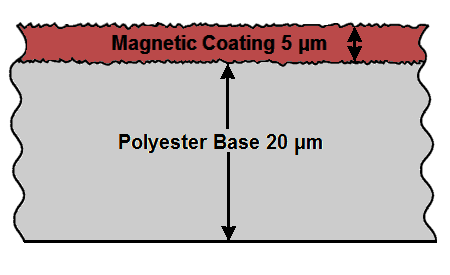
magnetic cartridge – see phonograph cartridge.
magnetic coating – a finely ground powder of ferric oxide, chromium dioxide, other metallic oxides, powdered iron metal (metal particles), or a mixture of these that is combined with a binder and applied to the base of a magnetic recording tape. See tape types. Magnetic coatings are also used to coat the platters of hard drives. Also called a top coat, magnetic layer, magnetic particles, pigment, or magnetic oxide (although technically magnetic oxide does not include metal particle tape nor metal evaporated tape).
magnetic constant (μ0) – see magnetic permeability.
magnetic dipole moment (μ) – the strength of a magnet (or current-carrying coil), expressed as the torque per unit magnetic flux density produced with the axis of the magnet perpendicular to the magnetic field. Also called magnetic moment.
magnetic field – the invisible force created by magnetic particles and objects that pulls on iron objects and attracts or repels other magnetized objects. A magnetic field generated by a current is designated as B. However, when the generated field passes through a magnetic material, which also contributes its own magnetic field, another magnetic field quantity designated as H is used and is usually called the magnetic field strength. It is defined as B = μ0 × H, where μ0 is the magnetic permeability of free space. H is measured in units of amperes per meter (A/m) in SI units or in oersteds (Oe) in CGS units. B is measured in teslas (T) or newtons per meter per ampere [N/(m-A)] in the SI or gauss (G) in CGS.
magnetic field strength – see magnetic flux density and magnetic field.
magnetic film – magnetic recording tape manufactured using the same base as 16-mm, 35-mm, or 70-mm film stock, that contains a magnetic strip running longitudinally down the film for the recording of an audio track or tracks. Magnetic film is the same thickness as regular film so that it will be the same size as a reel of film. It comes in full-coat, which has magnetic oxide applied across its entire width, or as striped magnetic film, which has one or more thin stripes of oxide applied longitudinally on the film base. Magnetic film has not been used much since the advent of digital movie sound. Called mag for short. See also sound follower.
magnetic film recorder – see sound follower.
magnetic flux (Φ) – the measure of the flow or strength of a magnetic field, usually measured in the SI unit of weber (Wb). The cgs unit is the maxwell (Mx), equal to 10-8 Wb. Magnetic flux is the magnetic equivalent to current.
magnetic flux density (ΦB) – the measure of the strength of a magnetic field passing through a given area, usually measured in teslas (T), which is equivalent to webers per square meter (Wb/m2). Also called magnetic field strength.
magnetic force – (1) The force exerted between magnetic poles that produces magnetization. (2) A force that exists between two electrically charged moving particles.
magnetic induction – the process by which a material, such as iron or steel, becomes magnetized by a magnetic field. The induced magnetism is produced by the force of the field radiating from the poles of a magnet.
magnetic instability – the property of a magnetic coating in which variations in the residual flux density occur with temperature, time, and mechanical flexing. Magnetic instability is a function of particle size, magnetization, and anisotropy. It tends to increase print through and to decrease low-frequency output with time and/or use.
magnetic layer – see magnetic coating.
magnetic media – devices that store information using patterns of magnetism on a magnetic coating, such as magnetic recording tape, floppy disks, and hard drives. Compare with optical media.
magnetic moment – see magnetic dipole moment.
magnetic oxide – see magnetic coating.
magnetic particles – small particles of magnetic material used in magnetic coatings.
magnetic permeability (μ) – the measure of the ability of a material to support the formation of a magnetic field within itself. It is the degree of magnetization that a material obtains in response to an applied magnetic field. Magnetic permeability is measured in henries per meter (H/m), or newtons per ampere squared (N/A2). The permeability constant (μ0), also known as the magnetic constant is the permeability of free space and is a measure of the amount of resistance encountered when forming a magnetic field in a vacuum. The magnetic constant has the defined value of 4 × π × 10‑7 H/m or approximately 1.2566370614... × 10‑6 H/m or N/A2. Also called permeability.
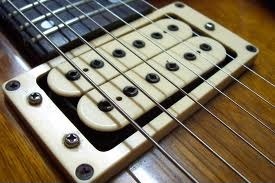
magnetic pickup – a transducer used to convert the vibrations of string instruments, such as electric guitar and electric bass, into an electric signal that can be amplified. A magnetic pickup consists of a permanent magnet wrapped with a coil of several thousand turns of fine enameled copper wire. The pickup is most often mounted on the body of the instrument, but can be attached to the bridge, neck, or pickguard. Sometimes called an electromagnetic pickup or electronic pickup. See also piezo pickup.
magnetic polarization – see magnetization.
magnetic pole – one of the two ends of a magnet (either artificial or natural) to and from which the lines of magnetic force are directed.
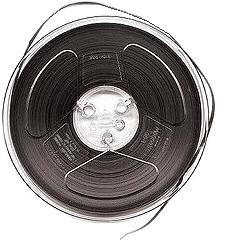
magnetic recording tape – a recording medium consisting of a base, thin strips of plastic (typically polyester), covered with a magnetic coating (finely ground magnetic particles such as ferric oxide, suspended in a binder). It may also have a back coating. It can be used to record audio, video, and digital data. Audio recording tape comes on 3-inch, 5-inch, 7-inch, and 10½-inch reels, and in ¼-inch, ½-inch, 1-inch, 2-inch, and (rarely) 3-inch widths, and in thicknesses of 0.5 mil (0.0005 inch) to 1.5 mil (0.0015 inch). The thinner tapes can fit more tape on a given size reel, but are more easily damaged, are harder to handle, and more susceptible to print through. See also videotape.
magnetic recording tape era – see magnetic tape era.
magnetic strip – see magnetic stripe.
magnetic stripe – a strip of magnetic material applied to some film used to record sound in place of or in addition to the optical soundtrack. Sometimes called a magnetic strip.
magnetic tape – see magnetic recording tape.
magnetic tape era – the portion of recorded music history from about 1947 to 1982. During this period, records were produced by first recording to tape before creating a disc. Beginning with a single track, recording technology progressed to two, four, eight, sixteen, and eventually to 32 tracks, providing for easier and more creative mixing. Prior to this era, audio was recorded directly to the disc. In about 1982, the digital era began with the introduction of the compact disc. Also called magnetic tape recording era or the high-fidelity era. Some historians break this period down further into the monaural era and the stereo era.
magnetism – a physical phenomenon produced by the motion of an electric charge, resulting in attractive and repulsive forces between objects.
magnetization – (1) The process of imparting magnetism to a magnetic material. (2) The density of permanent or induced magnetic dipole moments in a magnetic material, due to microscopic electric currents resulting from the motion of electrons in atoms. Magnetization results from the response of a material to an external magnetic field along with magnetic dipole moments inherent in the material itself. (3) The way a material responds to an applied magnetic field and the way the material changes the magnetic field. Also called magnetic polarization. British spelling magnetisation.
magnetize – to induce magnetic properties in an object. In other words, to make magnetic. British spelling magnetise.
magneto-optical (MO) – pertaining to or using both optical and magnetic phenomena or technology.
magneto-optical disc – a disc made of plastic or glass that is coated with a special compound with special optical, magnetic, and thermal properties. The disc can be read using a low-intensity laser.
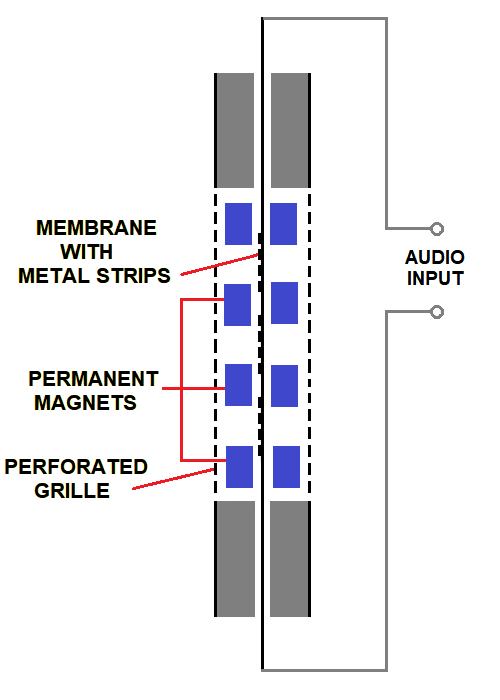
Loudspeaker
magneto-optical drive (MO drive) – a disc drive that can write and rewrite data upon a magneto-optical disc. They are optical but they appear as hard disk drives to the operating system and do not require a special file system.
magnetostatic loudspeaker – a type of flat-panel loudspeaker that uses an array of metal strips bonded to a large film membrane. A signal flowing through the strips produces a magnetic field that interacts with the magnetic field of permanent bar magnets mounted behind the strips, which causes the membrane to move, producing sound. They are similar to an electrostatic loudspeaker, but instead of using high voltages, magnetostatic loudspeaker use high currents. Magnetostatic speakers are usually less efficient than conventional moving-coil speakers. Sometimes called magnetostat for short.
magnetostriction – the property of a ferromagnetic material that causes it to change shape or dimensions when magnetized. The phenomenon was first observed by James Joule in 1842.
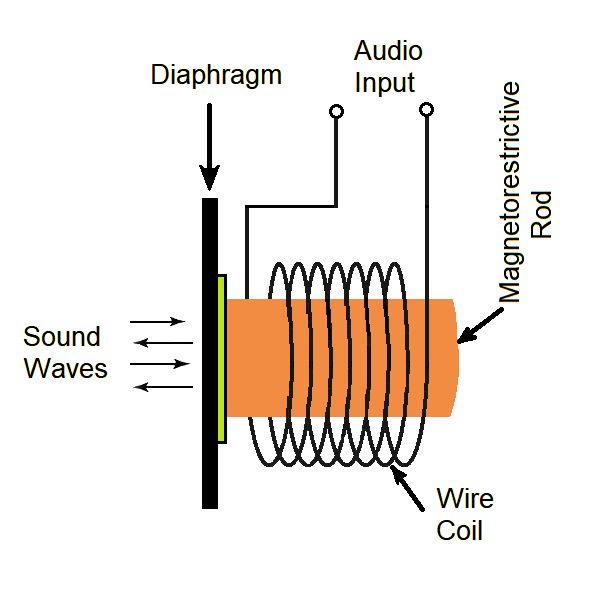
Loudspeaker
magnetostrictive loudspeaker – a type of loudspeaker that uses magnetostriction. The advantages of magnetostrictive speakers are (a) they can create a greater force with smaller excursions than other speaker types, lowering the potential for distortion caused by large excursions, (b) the magnetizing coil is stationary, which makes it easier to cool, and (c) they are also rather robust because there is no delicate suspension or voice coil.
main channel – see master bus.
main loudspeakers – see main speakers.
mains – (1) Short for main speakers. (2) British term for the electric power supply, analogous to the US term water mains for the water supply.
mains cable – British term for a power cord.
mains multiblock – British term for a power strip.
main speakers – the speakers facing the audience at a live venue and intended for the audience to hear, as opposed to monitors intended for the performers to hear. Called mains for short.
major scale – a diatonic scale with each note separated by a whole tones except between the 3rd and 4th and the 7th and 8th notes, which are separated by semitones. Also called the Ionian scale or mode. See chart of circle of fifths.
makeup gain – an increase in level following a process that has reduced the level, used most commonly on compressors where the overall level is brought back up after the signal has been compressed.
making beats – (1) Slang for recording a drum track, using either a real drum kit, drum machine, or synthesizer. (2) In hip hop music, slang for composing a music track typically using a drum machine, synthesizer, and various sampled sounds. This is the track to which rap and other vocals are often added.
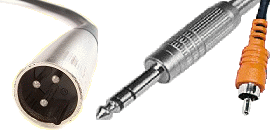
male connector – a connector attached to a wire, cable, or hardware device that has one or more exposed electrical terminals (prongs) that can be securely inserted into a matching receptacle (female connector) making a good physical electrical connection. A male connector can be easily recognized because the prongs are clearly visible when it is disconnected. Also called a plug.
mallet – see beater.
MAN – Metropolitan Area Network.
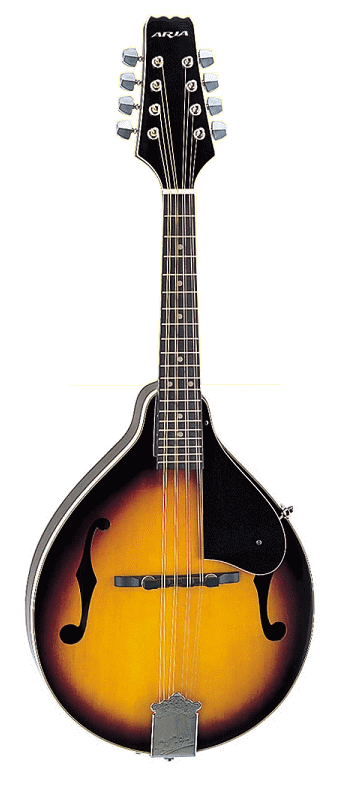
mandolin – a small lute-like instrument typically with a pear-shaped body and a straight fretted neck, with four sets of paired strings.
mandolin rail – a device installed in an upright piano to create the honky-tonk piano sound. The rail consists of a wooden rod placed in front of the piano strings with strips of leather hanging from the rod. Buttons made of steel or brass are attached to the string side of each strip. When the piano is played the hammers hit the metal buttons against the strings, resulting a metallic honky-tonk sound. The rail is usually hinged so that it can be rotated out of the way when not in use.
Manley Laboratories, Inc. – a company headquartered in Chino, Ca, and founded in 1993 by David and EveAnna Manley, that manufactures high fidelity and professional studio products under the Manley and Langevin brand names. In 1996, David Manley left the company and EveAnna Manley took over as CEO in 1999.
manual – a keyboard on a pipe organ.
MAP – Minimum Audible Pressure.
mapping – assigning a function to a control for which there is none or that is different from the standard function. This is a common process in MIDI in which a key map will translate values for MIDI messages so that the keys will play a particular sound or patch.
marcia moderato – a musical term indicating a moderate tempo, like a march, typically 83 to 85 bpm. See chart of tempo terms.
margin – see headroom.
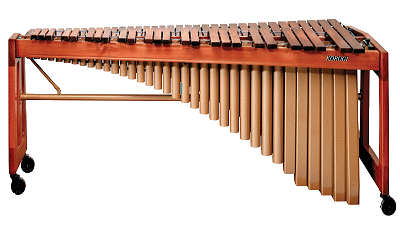
marimba – a Latin American percussion musical instrument that consists of a set of wooden bars of various lengths placed over long tuned metal resonators, played with two yarn-covered mallets in each hand. It is simi lar to the xylophone, which has shorter resonators, and the vibraphone, which has metal bars and resonators with rotating discs that produce vibrato.
marker – a location on the timeline of a DAW, used to indicate sections of a song (such as verses, choruses, or bridges), places to be edited, or other important points in a session. Other DAWs refer to this as a timeline marker, memory location marker, location point, or locate point.
marker dots – see fret markers.
mark-in/mark-out points – the beginning and end of a portion of an audio or video clip that is to be acted upon in a DAW, audio editor, video editor, or synchronizer. Typically transports start at the mark-in point and end at the mark-out point, but sometimes return to the start. Sometimes pre-roll and post-roll times are added to the mark-ins and mark-outs, either manually or automatically. Also called in/out points or clip in/clip out points.
marry – to combine audio and picture onto the same strip of film, such as on a release print.
Marshall Amplification – a company founded by Jim Marshall and based in Bletchley, Milton Keynes, Buckinghamshire, UK, that that designs and manufactures guitar amplifiers, speaker cabinets, headphones, drums, and modeling amplifiers. Marshall amplifiers are known for their distinctive crunch and their high output volume. Marshall added drums to its line with the purchase of Natal Drums (previously known as Natal Percussion Company) in 2010.
Marshall Electronics – see MXL.
Martin Guitars – see C. F. Martin.
Martin Audio – see Focusrite.
MAS – MOTU Audio System. A plug-in format used by MOTU for use with its software. It is not compatible with plug-in formats used by competitors, but can be utilized with some DAWs by using a wrapper.
masking – the phenomenon of a loud sound preventing the hearing of softer sounds of similar frequency. See also temporal masking and perceptual coding.
mass law – a law of physics that states that the ability of a material to reduce the transmission of sound is proportional to its weight. For each doubling of the weight of a wall, there will be 6 dB of sound reduction.
master – (1) Short for master recording. (2) The original master recording on a medium from which commercial copies are made, such as a lacquer master for pressing vinyl discs or a glass master for replicating compact discs. (3) The main control used to set the output level from a device or submix. (4) The device used as a timing reference when synchronizing two or more devices to run together. The devices that follow the master are called slaves. (5) Short for master bus or master fader.
master bus – the main output from a console, mixer, or DAW, usually a two-channel stereo signal, controlled by the master fader. Also called master channel, master track, mix bus, main channel, or in some DAWs simply master.
master channel – see master bus.
master clock – a clock that sends a separate timing signal to all slaves to maintain synchronization among several devices. For greater stability, the master clock sometimes uses an oven-controlled crystal oscillator (OCXO).
master disc – see lacquer master.
Mastered for iTunes (MFiT) – now known as Apple Digital Masters.
master fader – the main fader used to control the output from a console, mixer, or DAW.
mastering – (1) The final stage between mixing and replication, in which track levels are adjusted, compression and limiting are added, and equalization is used when necessary to produce a polished sound. Tracks are placed in the desired order and appropriate spacing is inserted between tracks. Mastering also helps ensure the best translatability across all playback devices. (2) Previously, the process for transferring audio from a magnetic tape (called the master tape) to a master disc used in the manufacture of vinyl phonograph records. (3) Another name for the compact disc replication process. Sometimes called CD mastering.
mastering engineer – (1) A person skilled in the process of preparing and transferring recorded audio from the final mix to a master, prior to replication. The process involves adjusting levels and adding compression, limiting, and equalization when necessary to produce a polished sound. The mastering engineer places tracks in the desired order and inserts appropriate spacing between tracks. (2) A vinyl mastering engineer.
master of ceremonies (MC) – a person who acts as a host at an event or program, such as a television show, and usually introduces the guests, speakers, performers, or entertainers. Also called an emcee.
master project (MST) – see master session (MST).
Master Quality Authenticated (MQA) – an audio codec for reproducing high resolution audio that can be stored as a file that is small and convenient to download or stream, without the loss of audio quality that is usually associated with compressed files. MQA was introduced by Meridian Audio in 2013, but is now owned and licensed by MQA Ltd. Meridian claims that MQA exceeds the sound quality of all current hi-res formats without the need for high sample rates, while remaining backwards compatible with current playback devices and streaming services. Utilizing a new digital sampling technique, MQA uses a type of apodizing filter instead of the brickwall filtersbrickwall filters used in conventional analog-to-digital converters to reduce aliasing. Then a high-res file is divided into 3 sections, Part A from 20 Hz to 22.05 kHz (or 24 kHz), Part B from there to 44.1 kHz (or 48 kHz), and Part C from there to 88.2 kHz (or 96 kHz). Then the information in Part C is reduced and “encapsulated” and then folded back to be place in the space beneath the noise floor in Part A. Next Part B is folded back beneath C in Part A. This process is called “Music Origami” by Meridian. This technique produces a 44.1-kHz or 48-kHz file (depending on the original sample rate), can be played by conventional devices. However, when played back on an MQA-compatible device, MQA first authenticates a file by checking for a code hidden within the file to ensure it is a true MQA-compatible file. If so, the file is converted back into the hi-res representation of the original master recording. It can use any lossless audio format, such as WAV, FLAC, or Apple Lossless. If the file is replayed without an MQA decoder, the encapsulated data is ignored and audio quality is supposedly somewhat better than CD quality.
master recording – an original sound recording from which copies can be made. The master recording is usually owned by a producer or record company. See master and master rights.
master recording license – see master rights.
master recording rights – see master rights.
master rights – the rights granted by a record company or producer to make copies of a
master recording. Master rights do not include the rights of the musical composition (song). The songwriter controls the right of the musical composition by way of copyright. Also called recording rights, reproduction rights, or master recording license. See also mechanical license and performance rights.
master session (MST) – the name recommended in “Digital Audio Workstation Guidelines for Music Production” by the Producers and Engineers Wing of the Recording Academy for the main or central session from preproduction through the recording and overdubbing phase. All the work may be done in this session, but any tracks recorded, edited, or processed in other sessions should be transferred back to the master session. It should include all the tracks intended for the final mix. There should be only one master session per song. The master session should be labeled “Song Title-MST.” The alternate name is master project (MST). See also slave session, source session, and mix session.
master tape – in analog recording, the magnetic recording tape containing the final mix of a song from which a master disc will be created to manufacture vinyl records. Sometimes called a master track.
master track – (1) The master tape. (2) The master bus.
matchboxing – see windowboxing.
matched pair – two microphones of identical make and model that have been tested and found to have nearly identical performance characteristics. Such microphones are often chosen when using stereo microphone techniques to minimize any differences between the two mics.
matched pole-zero mapping – see pole-zero mapping.
matched Z-transform method – see pole-zero mapping.
material exchange format (MXF) – an SMPTE standard container or wrapper format for digital video and digital audio content. The wrapper contains content encoded using any one of several compression methods plus timecode and metadata that describes the material contained within the MXF file. MXF includes a subset of the advanced authoring format (AAF) so as to be compatible with AAF devices. See also BXF and XML.
matrix area – see run-out groove area.
matrix encoding – a method of embedding multiple audio channels into a two-channel audio signal. Matrix encoding inherently has more crosstalk than discrete digital channels. Examples of matrixed surround formats include Dolby Surround and Dolby Pro Logic.
matrix mixer – a type of mixer that allows any input to be routed to any output, using a very elaborate busing system.
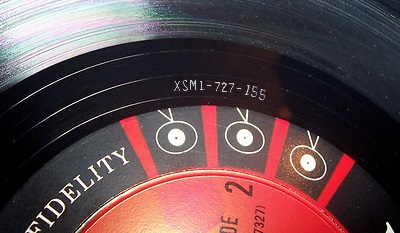
matrix number – the numbers and other symbols stamped and/or handwritten in the run-out groove area of a phonograph record or in the area near the hub of compact discs (CDs). The matrix number is for internal use by the record manufacturing plant, but they are also of interest to record collectors, because they sometimes can provide useful information about the edition of the record. Matrix numbers are usually, but not always, different from the record catalog number. They contain information to identify for which side of the record a stamper was made to ensure each side receives the correct label. They also can contain additional information, such as cut number, take number, record plant codes, initials or signature of the disc cutting engineer, cutting dates, copyright dates, and logos.
matrix switch – see switch matrix.
maximizer – a name sometimes applied to a limiter that is specifically used in mastering to add perceived loudness to a signal.
maximum operating level (MOL) – see maximum output level.
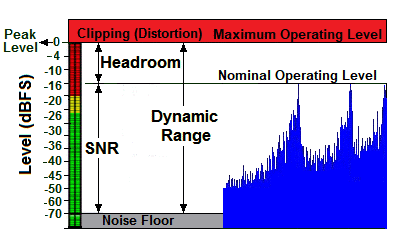
maximum output level (MOL) – (1) The voltage level for a device at its maximum usable audio level, with no headroom. For analog signals, maximum output level is often defined as the highest output that does not exceed 3% total harmonic distortion (THD). For digital signals, it is defined as 0 dBFS. Also called maximum operating level (MOL). See also nominal operating level. (2) For magnetic tape the magnetization level at which a recorded 1-kHz sine wave reaches 3% third-harmonic distortion. The MOL for magnetic tape is frequency and speed dependent. It saturates faster at higher frequencies and the distortion point is lower at slower recording speeds.
maximum signal level – see maximum output level.
maximum SPL – a specification for microphones that indicates the highest sound pressure level that a mic can handle without distortion, typically specified with a maximum total harmonic distortion (THD) of 0.5% (sometimes 1%) at 1000 Hz. A THD of 0.5% is the point where the distortion can be measured, but cannot be heard. Called max SPL for short.
maxwell (Mx) – the CGS unit for magnetic flux, named after James Clerk Maxwell, who developed the unified theory of electromagnetism. One maxwell is equal to 10‑8 webers, the SI unit. It is equivalent to one gauss-cm2. In other words, a magnetic field with a strength one gauss, one maxwell is the total flux across a surface of one square centimetre perpendicular to the field.
mb – abbreviation for megabit.
Mb – abbreviation for Megabit.
mB – abbreviation for megabyte.
MB – abbreviation for Megabyte.
Mbps – abbreviation in common usage for million bits per second, measure of transmission speed, but the correct usage should be Mibps (mebi bits per second. See mebi.
MBps – abbreviation in common usage for million bytes per second, measure of transmission speed, but the correct usage should be MiBps (mebi bytes per second. See mebi.
MBWF – Multichannel Broadcast Wave Format. See RF64.
MC – (1) Moving Coil. A type of magnetic phonograph cartridge. (2) MusiCassette. See cassette. (3) Master of Ceremonies.
MCA, Inc. – Music Corporation of America, an American media company originally based in Chicago, Illinois. It began business in the music industry as a record label and music publisher, but branched off into the movie industry and later into the television business. MCA's music business merged into the Universal Music Group, while its entertainment business was acquired by NBC/Universal, which in 2013 became a wholly owned subsidiary of Comcast.
MCI – Music Center Incorporated.
MCPS – Mechanical Copyright Protection Society. See MCPS-PRS.
MCPS-PRS – The MCPS-PRS Alliance Limited. MCPS-PRS is a performance rights organization in the UK that protects the rights of artists and publishers and collects and distributes royalties to its members. The MCPS-PRS Alliance was formed in 1997 as a merger of two collection societies: the Mechanical-Copyright Protection Society (MCPS) and the Performing Right Society (PRS). It goes by the branding name, “PRS for Music.” It is similar to BMI, ASCAP and SESAC in the US.
MCU protocol (Mackie Control Universal) – a proprietary communications protocol for interfacing between a hardware audio control surface and a digital audio workstation (DAW) to exchange MIDI signals that synchronize sliders, buttons, wheels, displays, and other controls. This protocol began with the introduction of Logic Control, a control surface jointly designed by Emagic and Mackie for the Logic Pro DAW software. Later the same year, Mackie introduced a physically identical product called “Mackie Control” which worked with most DAW applications other than Logic. The Emagic Logic Control was still available, but only worked with Logic. Later, the Mackie Control firmware was updated making it compatible with Logic. The name then was changed to “Mackie Control Universal” (MCU). Although proprietary, the protocol has become somewhat of a de facto standard. See also EUCON
MD – MiniDisc.
MDA – Multi-Dimensional Audio.
MDM – Modular Digital Multitrack.
M&E – Music and Effects. The M and E in DME — the three components of a movie soundtrack without the dialog, used for foreign language dubbing. If the M&E stems are not available (without dialog), then they must be replaced either by cut effects or new foley tracks. Also called mufex or international version.
ME – Metal Evaporated. See metal evaporated tape.
mean – often used to mean an average, in particular the arithmetic mean. However, there are several other means including the geometric mean and harmonic mean. See also median.
mean free path – the average distance traveled by a sound wave between successive reflections. In an enclosure, the mean free path (l) of a single particle bouncing off the walls can be calculated using the formula l = 4V/S, where V is volume of the enclosure and S is total inside surface area of enclosure. This equation is used in the derivation of the Sabine formula.
meantone temperament – a tuning system or temperament that is a refinement of the just intonation. In this scheme the major thirds are made exact, which results in the fifths becoming slightly flattened in such a way that the errors of the just intonation is spread out over four fifths. This refinement reduces the dissonance and makes the fifths more acceptable. Whole steps (tones) are all equal in size and are equal to √ 1.25 = 1.11803. Semitones = √ 2/(1.25)5/2 = 1.06998 This makes the mean-tone temperament more melodically acceptable than the just intonation. See table below. See also Pythagorean tuning, harmonic series tuning, and equal temperament.
| Musical Interval |
Frequency Ratio to Tonic |
Interval Step |
|---|---|---|
| Tonic | 1:1 | — |
| 2nd | 1.118:1 | 1.118 |
| 3rd | 1.250:1 | 1.118 |
| 4th | 1.338:1 | 1.070 |
| 5th | 1.495:1 | 1.118 |
| 6th | 1.672:1 | 1.118 |
| 7th | 1.869:1 | 1.118 |
| Octave | 2:1 | 1.070 |
measure – in music a segment of time defined by a given number of beats as specified by the time signature and indicated by the space between two vertical bars. Also called a bar.
measurement microphone – a microphone with an uncolored and nearly flat response designed for use with an audio analysis system that measures the acoustical characteristics of a room or space. They come in three response types. Sometimes called a calibration microphone or test microphone.
measure signature – see time signature.
mebi- – one of the new binary prefixes approved by the IEC and used to distinguish between binary and decimal prefixes. The term mebi- represents 1,048,576 (220) versus mega- which represents 1,000,000 (106). For example, you would use 24 mebibits, abbreviated 24 Mib, or 24 megabits, abbreviated 24 Mb.
mechanical coupling – a rigid connection between two isolated objects. When an acoustically isolated room transmits sound vibrations, it is frequently due to a mechanical coupling created during construction. For example, two isolated walls will become mechanically coupled if rigid electrical conduit is fastened to both walls. Other potential causes of mechanical coupling include air ducts and plumbing. Also called by slang term mechanical short.
mechanical decoupling – (1) Reducing transmission of physical vibrations between objects (mechanical coupling), typically accomplished by inserting a flexible material between rigid components. For example, using flexible electrical conduit instead of rigid conduit, using accordion-shaped canvas joints instead of rigid air-ducts, and using flexible tubing instead of hard plumbing pipes. (2) Sonically isolating an object from other objects, such as isolating a microphone from the stand by using a shock mount or a speaker cabinet from the wall or floor using an isolation pad. Also called mechanical isolation or vibration isolation.
mechanical isolation – see mechanical decoupling.
mechanical license – a license that grants the rights to reproduce and distribute copyrighted musical compositions (cover songs) on recorded media, such as CDs, records, DVDs, tapes, digital downloads, ringtones, and other formats (originally called “mechanically reproduced music”). A mechanical license cannot be used for the use of a song in a movie or video. That use requires a syncronization license. See also performance rights, mechanical rights, and master rights.
mechanical pickup – see piezo pickup.
mechanical rate – see statutory rate.
mechanical recording – see acoustic recording.
mechanical right – the right to reproduce a piece of music on recorded media (such as CDs, records, DVDs, and tapes), a right granted with a mechanical license. Producing sheet music is considered a non-mechanical reproduction, for which royalties are paid by the publisher to the composer. The reproduction of music on a soundtrack of a film or television show is called synchronization and requires a synchronization license.
mechanical rights societies – organization is various countries formed to administer and collect mechanical royalties (mechanicals) for their members for the statutory license agreements of music, literature, and dramatic works.
mechanical royalties – monies paid to copyright holders for a mechanical license or the right to manufacture and distribute a copyrighted song. Sometimes called mechanicals.
mechanicals – see mechanical royalties.
mechanical short – slang for mechanical coupling.
mechanical wave – a wave that transmits energy through oscillation of matter. Mechanical waves can be produced only in a medium that has elasticity and inertia. Unlike electromagnetic waves, they cannot propagate through a vacuum.
media – (1) The means for mass communication regarded collectively, such as television, radio, newspapers, and the internet. (2) The plural of medium.
media access control (MAC) address – a unique identifier, usually assigned to an interface by the manufacturer of a network interface controller (NIC), used as an address for communications on a network, especially IEEE 802 networks, such as Ethernet and Wi-Fi. MAC addresses are normally stored in the hardware's firmware or read-only memory. Also be known as an Ethernet hardware address (EHA), hardware address, or physical address.
media access control (MAC) header – see Ethernet header.
Media Composer – a film and video editing software application developed by Avid, originally released in 1989. It is a nonlinear editing (NLE) system that provides for both offline and online editing of uncompressed standard definition (SD), high definition (HD), 2K, and 4K video. The application is available in four versions: Media Composer|First (a freeware version), Media Composer, Media Composer|Ultimate, and Media Composer|Enterprise.
Media & Entertainment Services Alliance (MESA) – a trade organization of media companies that help their members increase efficiencies in the creation, production, and distribution of physical and digital media and entertainment, and provide market intelligence, research initiatives, industry advocacy, and collaborative workgroups. It now includes as a subgroup within MESA the Content Delivery & Security Association (CDSA), which began in 1970 as the International Tape Association (ITA). It later evolved into the International Recording Media Association (IRMA), a trade association that dealt with recording and recording media, such as raw material providers, manufacturers, replicators, duplicators, packagers, and copyright holders. Today the CDSA is mostly concerned with content and IP protection.
media file – a computer file containing images, audio, or video.
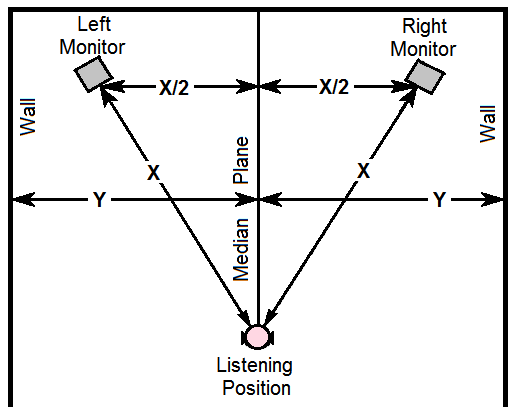
median – a type of average, represented by a value or number that lies at the midpoint of a distribution of values or numbers, such that there is an equal probability of falling above or below it. A median is often used when the collection of numbers has a few outlying values that are very large or small compared to the other values, which tends to skew an arithmetic mean. See also geometric mean, and median.
median plane – a plane along which all points are equidistant from the two studio monitors. If there are more than one set of monitors, they should all share the same median plane. The listening position should be on that plane at a distance that forms an equilateral triangle between the listener and the two speakers. This position provides the best phantom image and the best soundstage. Ideally the room should share that median plane, so that the side walls are equidistant from the median plane.
media player – (1) A portable electronics device used to store and play back media such as audio, images, and video files. They can be either digital (stored on a CD, DVD, flash memory, or hard drive) or analog (stored on cassette tapes or records). They are sometimes called MP3 players even when they can play other file formats and media types. The increase in sales of smartphones and tablet computers has led to a decline in sales of portable media players, although the Apple iPod and Sony Walkman are still being produced. Also called a digital media player (a term also used for a digital media streamer), digital music player, portable music player, portable media player (PMP), portable digital player, or digital audio player (DAP). (2) Software that plays audio or video files on the computer. The Windows Media Player by Microsoft is the default player for Windows computers, iTunes, RealPlayer, and other players are also widely used. QuickTime Player and iTunes are the default media players for the Mac.
mediant – the third note or third degree of a diatonic scale. It is called “mediant” (from the Latin medium for the middle) because its halfway between the tonic tonic and the dominant. A mediant chord is the triad formed using the mediant pitch along with other notes of the same diatonic scale. The mediant chord is usually symbolized by the Roman numeral iii (lower case indicates that the chord is a minor chord) in a major scale or III (a major chord) if it is in a minor scale. See also tonic, supertonic, subdominant, dominant, submediant, leading tone, and octave.
media stream – a continuous sequence of usually audio and/or video sent through a device or over a network or the internet. When sent over the internet, the stream is often compressed to keep bandwidth as low as possible. Also called an audio stream, video stream, or simply stream. See also streaming audio, streaming media, and data stream.
medium – (1) The material through which a sound is propagated, such as air and water. (2) The path used to transmit a signal, such as coaxial cable, twisted pair, waveguide, and fiber optics. (3) The physical material used to store information, whether it be data or music, such as magnetic tape, LP records, CDs, cassettes, punch cards, and computer hard drives. Also called recording medium. The plural is media.
medium diaphragm condenser (MDC) – a condenser microphone with a diaphragm size between that of small diaphragm condener and a large diaphragm condener, typically between ½ and 1 inch, although there is no strict size definition.
mega- (m) – the metric prefix for a factor of 1,000,000. It uses the lower-case m, while upper-case K is used to mean 1,048,576 (220), although this convention is not always strictly adhered to. Often called meg for short. See also mebi-.
megabit (mb) – one million bits.
Megabit (Mb) – a term in popular use for 1,048,576 (220) bits, but the correct term should be mebibit. See mebi.
megabyte (mB) – one million bytes.
Megabyte (MB) – a term in popular use for 1,048,576 (220) bytes, but the correct term should be mebibyte. See mebi.
MELF – Metal Electrode Leadless Face. Cylindrical electronic surface-mount components, usually diodes and resistors, that have non-lead-containing metal on each end. Although they are somewhat difficult to handle, they are used in high-reliability and precision applications. Their advantages are low failure rates, greater accuracy, long-term stability, moisture resistance, and high-temperature tolerance.
melisma – singing more than one note to a single syllable of the lyrics of a song.
mellow – a descriptive term for a sound with reduced high frequencies. See also gentle. Opposite of edgy.
melodeon – see accordion.
melodic interval – see interval.
melodic minor scale – see minor scale.
melody – a succession of notes arranged in a pattern of tones and rhythms to create a musical quality. Also called a tune.
Melodyne – a pitch correction processor developed by Celemony that measures the pitch of an audio signal, typically a vocal, and adjusts it to the correct pitch. It is used in many professional recording studios to manipulate audio signals in various ways, such as time stretching, melody rebuilding, and creating backing vocals from existing lead vocals.
mel scale – a scale of pitches that was judged by listeners under experimental conditions to have equal intervals from one another. As a reference, a pure tone with a frequency of 1,000 Hz and a sound pressure level of 40 dB was assigned a pitch of 1,000 mels. For notes above 500 Hz, listeners judged four octaves on the hertz scale to comprise about two octaves on the mel scale. A number of researchers have produced different results, leading to the conclusion that the data is flawed due to experimental errors. The name mel comes from the word melody.
membrane absorber – see panel absorber.
membranophone – a classifications for musical instruments in which a stretched membrane vibrates to produce sound according to the Hornbostel-Sachs system of musical instrument classification. Examples inlude a large variety of drums. The other four classifications are electrophone, idiophone, chordophone, and aerophone.
Memorex – a company established in 1961 in Silicon Valley to manufacture computer tape. It later expanded into computer peripherals and in 1971 into consumer audio tape. Purchased by Burroughs (which was later merged with Sperry to form Unisys) in 1982, the various divisions of Memorex were closed, sold, or spun off. In 1988 Memorex merged with the Telex Corporation becoming Memorex Telex NV, a Netherlands-base corporation. Memorex is now a brand owned by Imation for consumer electronics and audio accessories, such as portable audio players, television sets, Blu-ray disc players, flash drives, CDs, and DVDs, although few of these products are actually manufactured by Memorex or Imation.
memory – components in a computer used to store digital data.
memory card – a small, flat flash memory storage device typically used in digital cameras and cell phones. Examples include SD cards and SDHC cards.
memory location marker – see marker.
Memory Stick – (1) A type of flash memory storage device developed by Sony for use in digital cameras, camcorders, and other electronic devices. It is a proprietary Sony product used in almost all its products requiring flash media. As a result Memory Stick cards are incompatible with memory cards used in most products not made by Sony. (2) A slang term for a memory card.
mercury (Hg) – a chemical element that exists as a heavy, silvery liquid. It is the only metallic element that is liquid at room temperature and pressure. Mercury is used in thermometers, barometers, mercury switches, fluorescent lamps, and many other devices. In barometers, atmospheric pressure is indicated by how high the pressure pushes mercury up a tube, measured in inches or millimeters. The latter was once indicated as mm Hg, but now is shown as torr. Also known as quicksilver.
Mercury Records – a record label owned by Universal Music Group. The Mercury Record Corporation was formed in Chicago in 1945 by Irving Green, Berle Adams, Ray Greenberg, and Arthur Talmadge. In 1962, Mercury was acquired by Consolidated Electronics Industries Corp, an affiliate of Philips. In 1969, Mercury changed its name to Mercury Record Productions Inc. after its parent Consolidated Electronics became North American Philips Corp when Philips took control of the company. In 1972, Philips and Siemens reorganized their joint-venture company, Grammophon-Philips Group, (parent company of Deutsche Grammophon, Philips Records, and Polydor) into PolyGram. The same year, PolyGram purchased Mercury and changed its name to Phonogram Inc. In 1981, Mercury, and the other PolyGram-owned labels (Polydor, RSO Records, and Casablanca) consolidated under the new name of PolyGram Records, Inc. In 1998, PolyGram was acquired by Seagram, which placed it into its Universal Music Group.
Mercury triad – see omni triad.
merge – see consolidate.
Meridian Audio, Ltd. – a company founded in 1977 by Bob Stuart and Allen Boothroyd and headquartered in Huntingdon, UK, that manufactures high-end audio and video components and systems. They were the first company to introduce active loudspeakers intended for the consumer market. In 1983, they were the first UK company to manufacture CD players. Meridian has introduced several new technologies, including Digital Signal Processing (DSP) Loudspeakers and Meridian Lossless Packing (MLP), which is used in DVD-Audio and Dolby TrueHD as used on Blu-ray discs. In 2014, Meridian introduced Master Quality Authenticated (MQA).
Meridian lossless packing (MLP) – a proprietary lossless compression technique for audio data developed by Meridian Audio, Ltd. MLP is the standard compression method for DVD-Audio. Although all DVD-Audio players can decode MLP, its use on the discs is at the discretion of the producer. Dolby TrueHD uses MLP on Blu-ray discs. Also known as packed PCM (PPCM).
MESA – Media & Entertainment Services Alliance.
metadata – data about data. Historically, a card catalog in a library is an example of metadata. In the digital age, the information in a website header is metadata, as is the information contained in an ID Tag (metatag) of an mp3 file.
metafile – (1) A file that describes the contents of other files. It may contain metadata, that defines a group other files and provides a summary of the data those files contain. (2) A file used in computer graphics that defines objects and images defined by a list of coordinates.
metal evaporated (ME) tape – a magnetic recording tape with a magnetic coating with no binder consiting of a single, homogeneous metal alloy layer that is evaporated onto the tape base in a vaccuum. Used primarily for video tapes, ME tape has a higher signal level than other formulations and stabilities similar to metal particle tape, but because the magnetic layer is much thinner they are not as durable as other tape formulations.
metal particle tape – a type of magnetic recording tape that uses microscopic-sized particles of iron instead of iron oxide for the magnetic coating. It exhibits better performance than oxide tape, particularly at high frequencies and lower tape speeds, but it requires a different bias and equalization and tends to be less flexible and more abrasive to the tape heads, resulting increased shedding and head wear. Designated as Type IV. Also called metal tape or MP tape. See also metal evaporated tape.
metal tape – see metal particle tape.

metatag – metadata embedded in other files, such as the tag used to store information about a web page in an HTML file (but that is not displayed in Web browsers) or tags embedded in audio files that include song titles, artist names, and other information. See also ID tag.
meter – (1) A unit of length in the SI system equal to 100 centimeters or approximately 39.37 inches. Abbreviated as m. (2) An instrument used to measure and indicate a quantity. In the studio meters, such as level indicators, are used to indicate the recording level. (3) To watch closely the level of a signal. (4) In music, the pattern of notes or accents in a verse. British spelling metre.
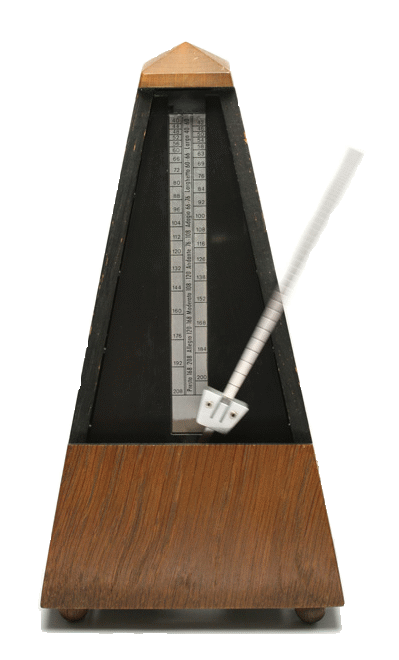
meter signature – see time signature. Also spelled metre signature.
metric sabin – see sabin.
metric system – see SI.
metronome – (1) A mechanical or electronic device that provides an audible sound (such as a click) or visual indication (moving arm or blinking light) at an adjustable rate, used for marking tempo for a musician, especially while practicing music. (2) The name used by some DAWs for a click track.

(Tempo = 60 bpm)
Metronome Marking (M.M.) – a notation typically found at the beginning of a musical composition that indicates the tempo using tempo terms (see Chart of Tempo Terms) or, more commonly today, beats per minute (bpm). Often the tempo is written as a quarternote equalling the tempo in bpm, but occasionally other notes are used. Originally it stood for Mälzel Metronome.
metropolitan area network (MAN) – a computer network larger than a local area network, covering the area of a few city blocks to an entire city and sometimes including the surrounding areas.
mezzo-soprano – (1) The vocal range of the adult female voice between soprano and alto or contralto, usually a range from the A below middle C to the A two octaves above (A3-A5). (2) The musical range between soprano and alto or contralto. (3) A singer whose voice is within this range. (4) A musical instrument that plays within this range. (5) A vocal or instrumental part written in this range.
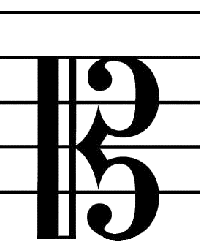
mezzo-soprano clef – the symbol on a music staff indicating that the second line from the bottom of the staff represents the pitch of middle C. One of five C clefs, the mezzo-soprano clef is mostly obsolete now.
MF – Medium Frequency. The portion of the radio frequency spectrum from about 300 kHz to 3 MHz. See the radio frequency chart.
MFiT – See Apple Digital Masters.
mho – see siemens.
MI – Musical Instrument or Music Industry.
mic – short for microphone. Sometimes spelled as the less preferred mike.
mic gain control – the device on a microphone preamplifier that sets the signal level.
mic/line switch – a selector switch on a device that chooses between a microphone input and a line level input.
mic input – short for microphone input.

mic level – short for microphone level.
mic pad – short for microphone pad.
mic preamp – short for microphone preamplifier.
micro- (μ) – the SI prefix for one millionth (10‑6). Abbreviated as μ, although u is sometimes used incorrectly.
microbar (μb) – one millionth (10‑6) of a bar, a unit to measure atmospheric pressure. One microbar is one thousandth of a millibar.
microbroadcasting – broadcasting a radio signal to a relatively small audience, such as a neighborhood or small town, often without a license under 47 Part 15 in the US. Not the same as low-power broadcasting.
microchip – one or more integrated circuits in a small, sealed housing with prongs that are used to connect it to equipment. Called a chip for short.
microcircuit – see integrated circuit.
microcomputer – a personal computer designed for use by one person. A microcomputer contains a CPU, memory, I/O ports, and a bus contained on a unit called a motherboard. The term microcomputer is normally used to distinguish it from minicomputers (medium-sized computers) and large mainframe computers.
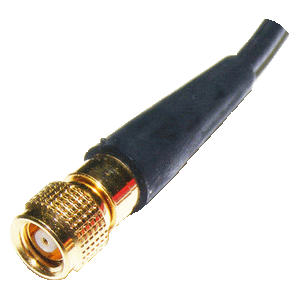
Microdot – a company, now owned by TE Connectivity, that manufactures small coaxial and multi-pin connectors. Their S-50 connector, a small coaxial connector that uses a 10-32 thread, has become known as “the Microdot connector” and is used in small microphones and other transducers.
microelectronics – (1) The science or industry that deals with the miniaturization of electronic circuits and components. (2) Devices, equipment, or circuits, such as microchips and microcircuits, that are produced using the technology of microelectronics.
microfarad (μF) – one millionth of a farad.
microgroove – the name applied to the narrower groove size that was first used for the 33⅓-rpm LP record. Prior to that, the standard record was a 78-rpm disc, with grooves ranging in width from 2.5 to 4 mm, with the wider versions being early on. By contrast, the microgroove was 75 μm (0.075 mm) wide, or about one-thirtieth as wide.
micrometer (μm) – (1) A unit of length in the SI system equal to one millionth (10‑6) of a meter. Also called micron. (2) A precision instrument for measuring very small distances.
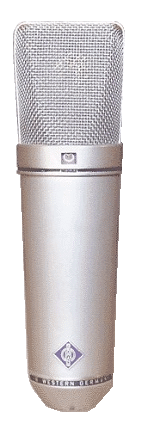
micromho (μmho) – one-millionth (10‑6) of a mho, a unit for measuring conductivity. It has been replaced by the SI unit microsiemens. One micromho equals one microsiemens. See siemens.
micron (μ) – a unit of length equal to one millionth (10‑6) of a meter. The more correct term is now micrometer (μm).
microphone – a transducer that converts sound waves into an electrical signal. There are several types of microphones, including the carbon microphone, condenser microphone, crystal microphone, dynamic microphone, moving coil microphone, and ribbon microphone. Carbon microphones and crystal microphone normally are not used in professional recording studios. In addition, there are a few other microphone types not mentioned here that are designed for specific applications not normally associated with recording studios. The three main types of studio microphones are summarized in the table below. See also Wikipedia: List of Microphone Manufacturers.
| Microphone Type: | Moving Coil | Ribbon | Condenser |
|---|---|---|---|
| Classification | Dynamic | Dynamic | Phantom Powered |
| Typical Polar Pattern | Cardioid | Figure 8 | Multi-patterned, Often Switchable |
| Durability | High | Low | Average |
| Typical Frequency Response | 70 Hz to 15 kHz | 50 Hz to 16 kHz | 20 Hz to 20 kHz |
| Sound Character | Solid | Smooth | Crisp |
| Diaphragm Weight | Heavy | Light | Average |
| Output | Average | Low | High |
| Transient Response | Good | Very Good | Excellent |
| Sensitivity | Average | Low | High |
| Typical Applications | Stage vocals, brass, drums, guitar cabinets | Strings, vocals, saxophones, brass, overheads | Vocals, piano, acoustic guitars, overheads |
| Examples | Shure SM57, SM58, EV RE20 | Royer R121, AEA R84 | Neumann U47, U87, AKG C414 |
| Cost | Low | Average | High |
microphone activator – see inline signal booster.
microphone array – a collection of several microphones arranged in a specific pattern and operating together, often linked to a computer that receives and interprets the sound into a usable form. Microphone arrays are used for a number of applications including surround sound, beamforming, extracting voice from ambient noise, and locating objects by sound.
microphone cable – a cable, typically balanced using XLR connectors (or sometimes other types), used to connect between a microphone and a preamp or other device. It carries a signal at microphone level.
microphone directionality – see polar pattern.
microphone directivity – see polar pattern.
microphone grille – see grille.
microphone input – a jack, typically an XLR (or sometimes a TRS), used to insert a microphone signal into a device, and that is at microphone level.
microphone level – the signal level output by a microphone, typically 1 to 3 millivolts. A microphone input, which usually uses a balanced XLR, is designed for low level signals that must be boosted with a preamp to be usable by audio equipment. See also signal level.
microphone mount – the device used to attach a microphone to a microphone stand, usually using threads on the end of the boom. It can be as simple as a clip, or as complex as a shock mount, or designed specifically for a given microphone.
microphone pad – a device to reduce the signal level coming from a microphone, placed before the preamplifier and sometimes on the microphone itself. See also pad.
microphone placement – the way in which a microphone is placed in relationship to the sound source being recorded. This process takes into consideration such things as close miking, distant miking, on-axis, off-axis, room miking, and many others. It is a key factor in capturing the desired sound in a studio. See also microphone technique and stereo microphone techniques.
microphone polar pattern – see polar pattern.
microphone preamp – short for microphone preamplifier.
microphone preamplifier – an amplifier that boosts the low-level signal output by a microphone (microphone level) to line level. Called microphone preamp or mic preamp for short. See also preamplifier.
microphone response types – a classification of microphone frequency responses. There are three response types: free-field, pressure, and random incidence. Measurement microphones (also called calibration or test microphones) come in all three response types. The three types have similar frequency responses at lower frequencies, but begin to differ as the frequency increases. The free-field microphone (also called a frontal incidence microphone) detects sound pressure directly at the diaphragm as if no microphone were present. It is most accurate for measuring single sources from a single direction and at 0° angle of incidence. It works best in areas with no reflections. Pressure response microphones are typically flush-mounted to a wall or in a cavity and measure pressure in front of the diaphragm without need for correction for it being present. The random incidence microphone (also called a diffuse-field microphone) receives sound pressures from multiple sources, coming from multiple directions, and with multiple reflections. Random incidence measurement microphones must account for their presence in the sound field. Omnidirectional microphone of necessity must be designed to be either free-field (close to the sound source) or diffuse-field (beyond the critical distance) and should be used accordingly. Some omni microphones have interchangeable grids that allow switching from one response type to the other.

microphone sensitivity – see sensitivity, definition #2.
microphone screw adapter – an adapter that converts a ⅝" mounting on a microphone stand commonly used in the US to the ⅜" size that is used on European mic stands. See microphone thread sizes.
microphone splitter – see splitter.
microphone stand – a device consisting of a metal tube(s) and a base used to hold a microphone so that the performer does not need to hold it. The stand can be vertical with telescoping tubes that allow for quick height adjustment and may have a boom arm attachment to provide for horizontal placement. It may be a heavy domed-shaped metal base or a folding tripod base. Stands come in a variety of sizes from the desk stand to the heavy duty overhead microphone stand. Called a mic stand for short.

microphone technique – (1) The method of selecting and placing a microphone to pick up a sound source in order to achieve the desired sound. See also microphone placement and stereo microphone techniques. (2) The way that a vocalist handles and sings into a microphone.
microphone thread sizes – a microphone mount is attached to a microphone stand using a threaded socket. The most common size in the US and Canada is 5/8-27, which has a ⅝-inch diameter and 27 threads per inch (tpi) unified straight thread (UST). In the UK and most of the rest of the world, a 3/8-16 size is used, which has a ⅜-inch diameter and 16 threads per inch (TPI) British Standard Whitworth (BSW). It is sometimes incorrectly called a 10-mm size. There is also a 1/4-20 (¼-inch and 20 tpi) frequently used to mount microphones to cameras, cameras to tripods, etc. A microphone screw adapter can be used to convert from one size to another.
microphonic – an undesired electrical noise caused by mechanical or audio-induced vibration of the components in an electronic device.
micropower broadcasting – see microbroadcasting.
microprocessor – an integrated circuit that contains the arithmetic, logic, and control circuitry for a computer. The main microprocessor is called the central processing unit (CPU). Sometimes other microprocessors are added to share the load with the CPU.
microsecond (μs) – one-millionth (10‑6) of a second.
microsiemens (μS) – one-millionth (10‑6) of a siemens.
Microsoft Corporation – a company founded in 1975 by Paul Allen and Bill Gates that develops software, operating systems (DOS and Windows), and many other computer related products.
Microtech Gefell – a manufacturer of professional recording microphones founded as a spinoff of a company founded by Georg Neumann. During World War II, Georg Neumann's factory in Berlin was bombed by Allied forces, and he moved the company to the town of Gefell in Thuringia, a state in eastern Germany, where he resumed production in 1944 as Georg Neumann & Company Gefell. After the war, Georg Neumann returned to Berlin in one of the Allied sectors and re-established his company as Georg Neumann GmbH. Meannwhile, Thuringia had come under Soviet control, and the company in Gefell became a state-run enterprise in East Germany. When the Berlin Wall was erected in 1961, Neumann's Berlin and Gefell facilities were separated. However, Neumann and his engineers in Berlin were able to maintain contact with the factory in Gefell until 1976, when Georg Neumann died. Due to West Germany's insistence, the Gefell factory changed its name to VEB Mikrofontechnik Gefell in 1972, but it continued to manufacture microphones using the Neumann name until the reunification of Germany in 1990. When the Berlin Wall came down in 1989, engineers from the Berlin visited the Gefell factory and were surprised at the advancements that had been made there since the two facilities had been separated. To many people, the Gefell operation is more deserving of the use of the Neumann name for its microphones since they still handmake the capsules using the techniques developed by Georg Neumann, and in light of the take over of the Berlin operation in 1991 by Sennheiser.
microtonal bend – see quarter-tone bend.
microwave – a wave in the radio frequency spectrum having a wavelength in the range of 1 mm to 10 cm or in the frequency range of 3 to 300 GHZ. Microwaves have frequencies just below infrared radiation, and are used for radar, satellite radio and television, microwave ovens, and a number of industrial applications.
microvolt (μV) – one millionth of a volt.
mic splitter – see splitter.
mic stand – short for microphone stand.
mid ormids – short for midrange.
mid-band frequency – see center frequency.
mid bass – one of four subdivisions into which bass is sometimes divided, covering the range of 80 Hz to 160 Hz. The other three subdivisions are deep bass (40 Hz to 80 Hz), low bass (40 Hz to 80 Hz), and upper bass (160 to 350 Hz), although these ranges vary from source to source. See also audio spectrum.
middle C – the music note C near the center of the piano keyboard, designated C4. The first C below the international pitch of A=440. It is represented as a note on the first ledger line below the staff on a treble clef or the first ledger line above the staff on a bass clef. The pitch equals 261.63 Hz and has the MIDI note number 60. See chart showing all the notes and their frequencies, as well as the corresponding MIDI note numbers.
middle eight – see bridge.
middle electret condenser microphone – see electret condenser microphone.
middle highs – see presence range.
midfield monitors – studio monitors (speakers) designed for listening at medium distances, typically six to ten feet. Midfield monitors are usually larger and more powerful than nearfield monitors, having larger cabinets, larger woofers (typically 8 to 10" or larger), and often using three-way designs. They are designed to provide more bass and deliver good mid- and high-frequency dispersion at greater distances, especially for larger listening rooms. See also far-field monitors.
mid frequency – see center frequency.
mid-frequency absorber – see porous absorber or resonant absorber.
MIDI – Musical Instrument Digital Interface. A system specifying the connections and communication protocols for synthesizers, digital instruments, electronic keyboards, computers, and other devices. These protocols are spelled out in MIDI Specification 1.0. Although originally intended for synthesizers, MIDI protocols have been extended to other areas such as DJ controllers, lighting consoles, and other devices.
MIDI 1.0 – see MIDI Specification 1.0.
MIDI 2.0 – see MIDI HD Protocol.
MIDI Association, The (TMA) – an organization established in 2016 by the MIDI Manufacturers Association for consumers and others interested in working, playing, and creating with MIDI. It created MIDI.org as a repository of information related to MIDI technology. With the growing recognition of The MIDI Association, the MMA decided to unify the two brands under the name The MIDI Association. The MIDI Manufacturers Association remains the legal entity, but the organization now does business as the MIDI Association.
MIDI cable – a cable designed to carry MIDI data . It consists of three shielded conductors with five-pin DIN plugs on each end.
MIDI CC – MIDI Control Change or Continuous Controller. A type of MIDI data used to control parameters like modulation, volume, pan and sustain. A MIDI controller with knobs and faders that can be programmed usuallyy send out MIDI CCs.
MIDI channel – the routing of MIDI data for one musical instrument or synthesizer. A MIDI cable can contain up to 16 channels.
MIDI-CI – MIDI Capability Inquiry. A MIDI specification established by the MMA that allows a device to recognize the functionality of other devices and to configure itself accordingly. It has three elements: Profile Configuration, Property Exchange, and Protocol Negotiation.
MIDI clock – the time data within a MIDI signal used to sync two sequencers together.
MIDI controller – a device (such as a keyboard or drum pads) played by a musician that outputs MIDI data.
MIDI data – the information contained in a MIDI signal that includes, among other things, what note to play, for how long, and at what intensity.
MIDI file – a file that contains MIDI data.
MIDI HD protocol – a proposed update to MIDI Specification 1.0, that will not become official until if and when it is approved by the MMA membership. Sometimes erroneously called MIDI HD or MIDI 2.0.
MIDI in – a connector on a device that accepts MIDI data.
MIDI interface – a device that converts MIDI data into a digital format that can be used by a computer and converts digital data into a MIDI signal.
MIDI keyboard – a piano-style keyboard device used as an interface for sending MIDI data over a USB or MIDI cable to other devices. A MIDI keyboard produces no sound, but sends MIDI signals to devices that reproduce sounds digitally or by using samples that emulate analog musical instruments.
MIDI Manufacturers Association (MMA) – an organization of companies that develops technical standards for MIDI technology. In 2016, the MMA established The MIDI Association (TMA) for consumers and others interested in working with MIDI. With the growing recognition of The MIDI Association, the MMA decided to unify the two brands under the name The MIDI Association. The MIDI Manufacturers Association remains the legal entity, but the organization now does business as the MIDI Association.
MIDI message – data sent by MIDI devices to communicate with one another, consisting of a status byte and up to two data bytes. MIDI message can be either a channel message that is transmitted on individual channels rather that globally to all devices in the MIDI network or a system message that carries information that is not channel specific, such as a timing signal for synchronization and detailed setup information.
MIDI note number – numerical values from 0 to 127 assigned to musical notes in the MIDI system. They cover the range of notes from C-1 to G9 (sometimes shown as C-1 to G9), which is more notes than on a standard 88-key piano. See chart showing the MIDI note numbers with the corresponding notes and frequencies. See also scientific pitch notation.
MIDI out – a connector on a device that sends MIDI data.
MIDI over USB – a protocol that allows a MIDI device to be connected directly to a computer without requiring a MIDI interface. Also called USB-MIDI.
MIDI pickup – a pickup on guitars and other instruments connectorconvert pitch-to-MIDI. Some systems do not actually do any onboard pitch-to-MIDI conversion, but are part of a system that includes a separate converter, but are still included in the category of MIDI pickups.
MIDI Polyphonic Expression (MPE) – a MIDI protocol in which note messages (pressure, velocity, etc.) are applied to a single note. Prior to this standard, pitch bend and control change messages applied to all notes on a channel. MPE solves this problem by sending each note's messages on a separate MIDI channel, rotating through a defined block of channels. Also called Multidimensional Polyphonic Expression.
MIDI sequencer – hardware or software that can record and playback MIDI data.
MIDI signal – a digital signal that contains event messages specifying notation, pitch, and velocity, control signals for parameters such as volume, vibrato, and panning, and clock signals used to synchronize tempo between multiple MIDI devices.
MIDI Specification 1.0 – the specifications for MIDI published by the MMA that describe (a) the electrical and mechanical connections between compatible devices and (b) the communications protocol for message formats.
MIDI thru – a connector on a device that duplicates the MIDI data and sends it to be used by another MIDI device, connected in series. Some devices do not have a MIDI thru connection and must be placed at the end of a MIDI chain. However, there are some hardware devices called MIDI Thru units or Thru boxes (splitters) that can be used in such situations.
MIDI thru unit – see MIDI Thru.
MIDI time code (MTC) – a method of embedding standard SMPTE timecode in a MIDI signal as a series of small quarter-frame MIDI messages, which are transmitted in a sequence of eight messages taking two frames to complete a timecode value. Unlike standard SMPTE timecode, the MTC messages carry a two-bit flag value that identifies the rate of the timecode as 24 fps (standard film rate), 25 fps (PAL video), 29.97 fps (drop-frame timecode for NTSC video), or 30 fps (non-drop timecode for NTSC video). Also called MIDI time division.
MIDI time division – see MIDI time code.
MIDI track – a track in a DAW designed to handle MIDI data.
midrange – (1) The middle range of audio frequencies to which the ear is most sensitive. (2) The portion of the audio spectrum from about 350 Hz to 5,000 Hz. It is sometimes broken down into two to four subparts, lower midrange (350 Hz to 600 Hz), middle midrange (600 to 1200 Hz), and upper midrange (1.2 kHz to 2.4 kHz), with the presence range (2.4 kHz to 5 kHz) sometimes included. Also called midrange frequencies, sometimes shortened to mid or mids.
midrange driver – the driver in a loudspeaker cabinet that reproduces audio frequencies in the midrange, typically 300 Hz to 5,000 Hz. It is sometimes called a midrange speaker or squawker.
midrange frequencies – see midrange.
midrange smear – a degradation in sound that produces a small amount of c in the midrange frequencies due to nonlinear frequency responses in the reproduction equipment. Also called grunge.
midrange speaker – see midrange driver.
midrange-tweeter-midrange configuration (MTM) – a loudspeaker configuration created by Joseph D'Appolito that is designed to to limit the radiation pattern so that there is less dispersion above and below the center axis of the speaker in order to minimize floor and ceiling reflections. In this configuration the tweeter is placed between two midrange drivers, with the size and spacing of the drivers being critical. Also called a midwoofer-tweeter-midwoofer configuration or the D'Appolito configuration.
mids – slang for midrange.
mid-side (M/S, M-S, or M&S) – a stereo microphone technique
that was patented in 1934 by Alan Blumlein, but was not used widely until Holger Lauridsen, an engineer with the Danish State Radio, began experimenting with it in the 1950s. With this technique, one cardioid microphone is faced forward and a second bidirectional (figure-eight) microphone is faced at 90 degrees from the same point. The sum and difference of the two signals are used to create left and right stereo signals using a mid-side matrix. The main advantages of M/S technique are (a) the stereo image can be adjusted after recording, (b) it has nearly perfect mono compatibility, and (c) the middle of the performers is on-axis with the microphone (whereas with most other techniques it is off-axis). Sometimes called mono-stereo or mit-seit in German. Sometimes abbreviated as M-S. It falls into the coincident pair category of microphone methods. Other coincident pair techniques include Blumlein array and X-Y pair. See also near-coincident pair (A-B, DIN, EBS, Faulkner array, NOS, ORTF, RAI) and spaced pair (A-B, Decca tree, spaced cardiods, spaced omnis). See table comparing various stereo microphone techniques. See also joint stereo or channel coupling.
mid-side matrix – an arrangement of channels on a mixer or DAW intended for processing signals from a mid-side (M/S) stereo microphone system. One matrix uses three channels: a channel for the mid (center) microphone, a channel for the side microphone, and a third channel for the side microphone with the polarity reversed. The three channels are mixed to produce two channels with varying degrees of stereo separation.
mid-side-mid (MSM) – see double mid-side.
midwoofer-tweeter-midwoofer configuration – see midrange-tweeter-midrange configuration.
mike – a less-preferred abbreviation for microphone. The preferred spelling is mic.
miking – the process of positioning a microphone in order to obtain the best quality of sound. Sometimes spelled micing, although that looks more like it has something to do with mice. See also microphone technique.
mil – short for milinch, a unit of length equal to 0.001 inch (0.0254 mm). Among other things, magnetic recording tape thicknesses are usually measured in mils.
milli- (m) – the SI prefix for a factor of one thousandth (10‑3).
milliamp – short for milliampere.
milliampere (mA) – a unit to measure small electric currents, equal to one thousandth of an ampere. Called milliamp for short.
millibar (mb) – one thousandth of a bar, a unit to measure atmospheric pressure. One microbar (μb) is one thousandth of a millibar.
millisecond (ms) – one thousandth of a second. Typically delays, reverberation, and latency are measured in milliseconds.
millivolt (mV) – one thousandth of a volt.
milliwatt (mW) – one thousandth of a watt.
mimesis – imitative representation of the real world in art, literature, and movies. See also diegesis.
mimetic – pertaining to or characterized by imitation or mimicry.

miniature phone plug – a 3.5-mm phone plug, available in both the TS and TRS configurations. Also called a 3.5-mm miniature plug, 3.5 mm miniplug, miniature phone plug, miniature plug, mini phone plug, or miniplug. Often incorrectly referred to an ⅛-inch plug. See also subminiature plug.
Mini CD – a smaller version of the compact disc, having a diameter ranging from 60 mm (2.4 in) to 80 mm (3.1 in) , but frequently called a “3-in” CD. Mini CDs have a capacity of about a third of a conventional CD. They were sometimes used for CD singles, containing up to 24 minutes of audio.
MiniDisc (MD) – a magneto-optical disc smaller than a compact disc used to record and playback music. It uses a form of compression called ATRAC.
Mini DisplayPort (MiniDP/MDP) – a miniaturized version of the DisplayPort digital interface, which is primarily used to connect video to a display. The MDP was developed and licensed by Apple beginning in 2008. However, in 2016 Apple began phasing out the MDP as it switched over to the USB-C connector.
Mini DV – Miniature Digital Video. A type of digital camcorder format for recording and playing back digital video. A Mini DV Cassette (DVC) can hold 11 GB of data on a tape 65 meters long.
minimum audible field (MAF) – the threshold of hearing as determined under free-field conditions. The threshold of hearing is normally measured using headphones, which is called minimum audible pressure (MAP). The minimum audible field thresholds are typically 6 to 10 dB higher than thresholds resulting from minimal audible pressure. Thresholds obtained under free-field conditions are more difficult to measure due to the necessity of extremely quiet conditions.
minimum audible frequency (MAF) – the lowest line on an equal loudness curve, corresponding to 0 dB SPL.
minimum audible pressure (MAP) – the threshold of hearing as determined using headphones. When the threshold is determined under free-field conditions, it is called minimum audible field (MAF). The minimum audible field thresholds are typically 6 to 10 dB higher than thresholds resulting from minimal audible pressure.
minimum-phase equalizer – a conventional analog equalizer, as opposed to a linear-phase equalizer. All analog equalizers introduce some phase shifts due to the latency created while boosting or cutting the affected frequency bands. While this is unavoidable, manufacturers try to reduce the amount of phase-shift as much as possible, and so they call them minimum-phase equalizers. Only digital equalizers can be designed as linear-phase equalizers. Sometimes called nonlinear-phase equalizer or natural-phase equalizer.
minimum-phase speaker – see time-coherent.
mini phone plug – see miniature phone plug.
miniplug – see miniature phone plug.
mini XLR connector – a smaller sized XLR connector used on on some wireless body-pack transmitters and on some boundary microphones. Currently the Mini XLR connectors are not covered by any national standards, and the wiring schemes are not standardized within the microphone industry.
minor chord – a chord having a root, a minor third, and a perfect fifth. A chord with just these three notes is called a minor triad. Minor triads with additional notes, such as the minor seventh chord, are also called minor chords.
minor flatted fifth – see diminished triad.
minor scale – a diatonic scale with each note separated by a whole tones except between the 2nd and 3rd and the 5th and 6th notes, which are separated by semitones, resulting in an interval pattern of tone-semitone-tone-tone-semitone-tone-tone. This is one of three variations on the minor scale and is called a natural minor scale or Aeolian scale or mode. A second variation is the harmonic minor scale, which is the same as the natural minor except that the seventh note is raised by one semitone resulting in an interval pattern of tone-semitone-tone-tone-semitone-1½ tones-tone. The third variation, the melodic minor scale, is the same as the natural minor scale except the sixth and seventh notes are raised by a semitone when the scale is ascending, but is the same as the natural minor when descending. The ascending pattern is tone-semitone-tone-tone-tone-tone-semitone. See chart of circle of fifths.
minor second – see second, definition #2.
minor seventh – see seventh.
minor sixth – see sixth.
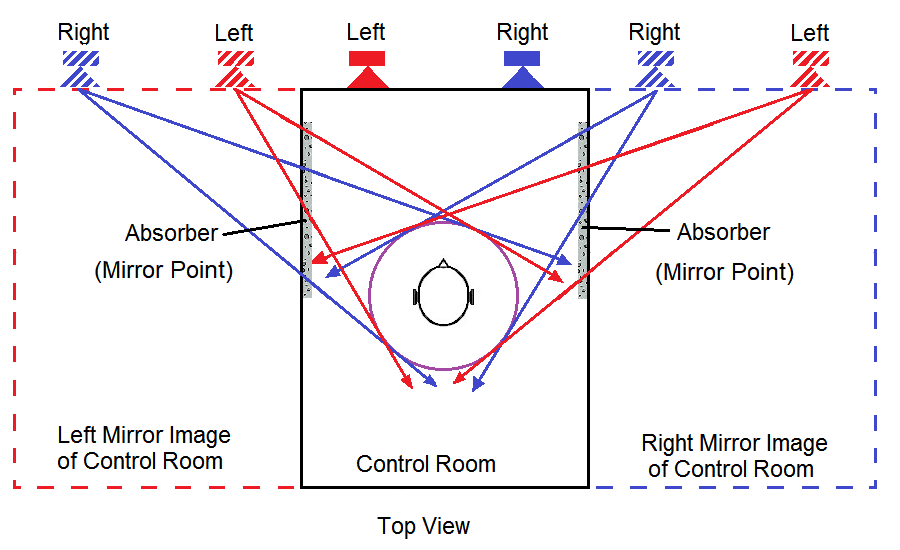
minor third – see third.
minor triad – see minor chord.
minute – (1) A unit of time equal to sixty seconds or 1⁄60 of an hour. (2) 1⁄60 of a degree of angular measurement. It uses the ' symbol.
mirror points – the positions on a wall or ceiling where, if a mirror were placed, the visual reflection of a studio monitor would be seen from the listening position. That point represents the place where sound waves from the monitor will be reflected directly to the listener and is the ideal location to place an acoustic absorber to prevent such reflections. See also reflection-free zone.
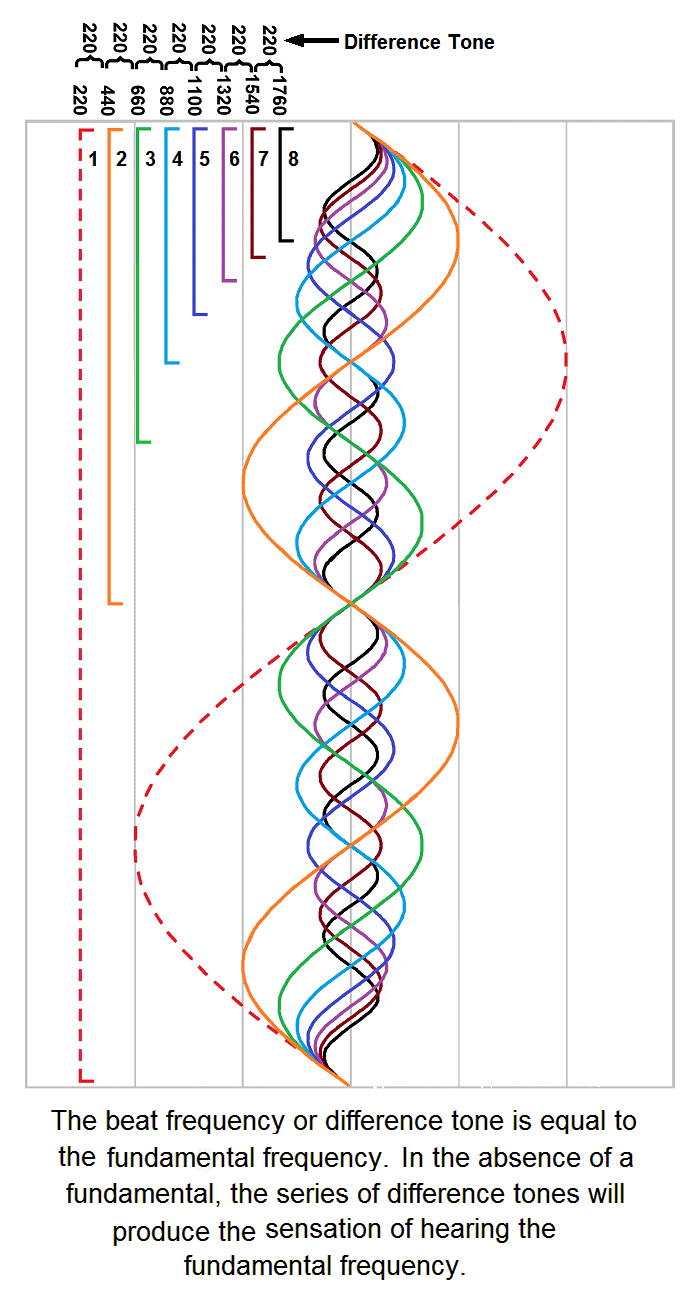
missing fundamental effect – the phenomenon in which a fundamental frequency is heard when a tone occurs containing several harmonics, but the fundamental is missing or significantly diminished. This phenonomenaon occurs because the beat frequencies of the various harmonics produce a difference tone with the same frequency as the fundamental.
Mitsubishi Electric Corporation – a multinational electronics and electrical equipment manufacturing company headquartered in Tokyo, Japan, founded in 1921. It is a member of the Mitsubishi Group, a group of companies that share the Mitsubishi name, trademark, and legacy, but are independently owned and operated. In the US, Mitsubishi Electric sells and manufactures its products through Mitsubishi Electric United States, headquartered in Cypress, California.
mix – (1) To combine or blend two or more signals or tracks into a single mono track, two stereo tracks, or several surround tracks. See mixing. (2) A recording that has been combined from several sources or tracks, i.e. the “mix.” (3) A control on a delay unit that blends the amount of wet and dry signal.
MIX – see mix session (MIX).
mix bus – see master bus.
Mixbus – a digital audio workstation developed by Harrison, that is designed to emulate an analog console, especially those built and designed by Harrison.
mix bus compression – applying a compressor to the entire mix of a recording, often by inserting it on the master bus or master fader. Sometimes called 2-bus compression or two-bus compression. Also spelled mix buss compression. See also bus compression.
mix down – (1) The process of combining the audio signals from a multitrack recording into a single mono track, two stereo tracks, or several surround tracks, following the mixing process. Also written as mixdown. (2) The audio signal resulting from combining the audio signals from a multitrack recording.
mix engineer – an audio engineer responsible for combining or mixing the various tracks (vocals, instruments, effects, etc.) of a recording session into a final version of a song, called the mix down or final mix. The object of mixing is to achieve a good balance of volume, panning, EQ, and other effects. Also called a mixing engineer.
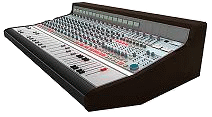
mixer – (1) A device that blends and controls the level of several audio signals. (2) The section of a
console that combines and blends a number of audio signals. (3) An audio engineer who mixes.
mixer automation – see automation.
mixer stage – a section found in some designs of radio receivers which uses frequency mixing to convert a received signal to a fixed intermediate frequency (IF) which can be more easily processed than the original carrier frequency.
mixing – the process of combining the audio signals from a multitrack recording into a single mono track, two stereo tracks, or several surround sound tracks, while adjusting levels and panning and adding effects such as equalization, compression, and reverberation to produce a pleasing sound. See also mix down.
mixing board – see console.
mixing console – see console.
mixing desk – a British term for a mixing console.
mixing engineer – see mix engineer.
mixing studio – see dub stage.
Mixolydian mode – one of the seven musical modes or scales with the interval pattern of tone-tone-semitone-tone-tone-semitone-tone.
mix project (MIX) – see mix session (MIX).
mix session (MIX) – the name recommended in “Digital Audio Workstation Guidelines for Music Production” by the Producers and Engineers Wing of the Recording Academy for a session used for mixing, either using a console or within a DAW. The mix session should be labeled "Song Title-MIX." There should only be one mix session per mix. The alternate name is mix project (MST). See also master session, slave session, and source session.
mix speaker check – using a second, different set of monitor speakers (secondary reference monitors) to determine how well a mix translates to other sound systems. These may simply be another brand of monitors, but quite often they are certain speakers acknowledged as having a bright or harsh sound. If a mix sounds good on this type of speaker, it will likely sound good anywhere. Some examples of these speakers are the Yamaha NS-10 (no longer manufactured, but emulated by the Avantone CLA-10), Auratone (updated as the Auratone 5C), Radio Shack Minimus 7 (no longer avaiable), or cheap computer speakers. Also called secondary speaker check, check monitors, cheap speaker check, “grot” speaker check, “grotbox” speaker check.
mix to disk – a function on some DAWs equivalent to bounce to disk.
MLA – Music Loudness Alliance.
MLP – Meridian Lossless Packing.
MLV – Mass-Loaded Vinyl. A heavy, flexible sheeting made from vinyl impregnated with metal particles to increase its mass and used for soundproofing. Typically MLV is sandwiched between other materials, such as between two layers of drywall, to diminish the transmission of sound through walls and ceilings.
MKS – Meter-Kilogram-Second, a version of the metric system, which has been superceded by the SI system. See also CGS.
M.M. – Metronome Marking.
MM – Moving Magnet. A type of magnetic phonograph cartridge. See phonograph cartridge.
MMA – MIDI Manufacturers Association.
MMC – MIDI Machine Control. A method for software to remotely control hardware using MIDI.
MMDS – Multichannel Multipoint Distribution Service.
MMF – MultiMode Filter.
MN-taper – a special taper used for potentiometers on home stereo balance controls, consisting of two sections (one for each channel) operating in opposite directions, with the first half of travel of each section having zero resistance and the second half being a linear taper. Also called a balance pot. Sometimes shown as M+N taper.
MO – Magneto-Optical.
mobile tv – see digital multimedia broadcasting.
mock stereo – derogatory term for simulated stereo.

mod – (1) Short for modification, such as in modifying a microphone. (2) Short for modulation, as in mod wheel.
modal distribution (MD) – a plot of the time vs. frequency distribution of low-frequency (usually less than 300 Hz), resonant sound waves (room modes) within a confined space.
modal harmony – music that (1) uses only one of the modes (Ionian, Dorian, Phrygian, Lydian, Mixolydian, Aeolian, and Locrian modes), (2) does not use a functional harmony, and (3) does not resolve to any other chord, but does have a tonal center (tonic or root note). Also called modality. Compare with tonal harmony.
modality – see modal harmony.
modal synthesis – a method used to synthesize sounds by modeling the sound of an object using a combination of modes, each of which vibrates independently of the others. This type of modeling is only accurate for sounds produced by linear phenomena, such as a the strings of a guitar.
modal voice – the vocal register used most frequently in speech and singing. In other words, it is the normal voice.
mode – (1) Short for room mode. (2) The arrangement of the eight notes in a diatonic scale according to one of several fixed schemes based on their intervals. These are known as the Ionian, Dorian, Phrygian, Lydian, Mixolydian, Aeolian, and Locrian modes. See chart of modes and scales. (3) An option that allows for a change in the method of operation of a device, such as a DAW being in record mode or in edit mode or a multimode filter being in high-pass or low-pass mode.
moderato – a musical term indicating a moderate tempo, typically 86 to 120 bpm. See chart of tempo terms.
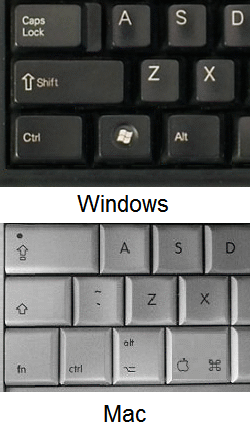
modifier key – a key on a computer keyboard used in conjunction with numeric keys, alphabetic keys, or mouse clicks to change the functionality. On a Winows keyboard, you have the Shift, Control (Ctrl), Windows (Win), and Alternate (Alt) keys. These correspond roughly to Shift, Command (Cmd), Option (Opt), and Control (Ctrl) keys on the Mac, but not always. See also keyboard shortcut.
modular digital multitrack (MDM) – a digital multitrack recorder (typically with 8 tracks) that can be synchronized with other machines of the same type to add additional tracks. Also called a modular recorder.
modular recorder – see modular digital multitrack.
modular synthesizer – see synthesizer.
modulation – (1) Imposing a signal onto a carrier wave by modifying a property of the wave, such as its amplitude, frequency, or phase. (2) The regulation, modification, or adjustment of one signal by another signal. (3) Modifying the behavior of a signal processor by inputting a secondary signal (called the key) by means of a side chain. (4) In music, the process of changing from one key to another, to add interest or musical expression. This is also called a key change.
modulation depth – see frequency deviation.
modulation effects – a group of audio effects that imposes, modifies, or adjusts one signal by another signal. Examples of modulation effects include chorus, tremolo, flanger, or phaser.
modulation index – see frequency deviation.
modulation lead powering – see A-B powering.
modulation leads – the conductors in a cable that carry the audio signals. Also called signal leads.
modulation noise – a hiss or other noise that occurs only when the main signal is present and varies in intensity with the intensity of the main signal. It is caused by the Barkhausen effect and is sometimes called Barkhausen noise. See also tape noise.

modulation wheel – one of the defined MIDI controller change messages. The modulation wheel typically is a wheel on the left side of a keyboard that can be programmed by the user to create an effect, such as vibrato or bending. Called mod wheel for short.
modulator – (1) A device that imposes a signal onto a carrier wave by modifying a property of the wave, such as its amplitude, frequency, or phase. (2) A device that regulates, modifies, or adjusts a signal. (3) A device that modifies the behavior of a signal processor by inputting a secondary signal (called the key) by means of a side chain.
mod wheel – short for modulation wheel.
MOL – Maximum Output Level or Maximum Operating Level.
Mojave Audio, Inc. – a microphone design and manufacturing company begun in 1985 in Fullerton, California, by David Royer. Although Royer is best known for his ribbon microphone designs with Royer Labs, he started out by designing and building vacuum tube condenser microphones, mic preamps, and compressors for engineers in the Los Angeles area. Mojave Audio, Inc. was launched in 2005 in Burbank, Califonria.
momentary loudness (M) – an instantaneous measurement of loudness measured over a 400-ms period as defined by the ITU BS.1770 standard, used for making initial settings of loudness. See also sliding loudness and integrated loudness.
monaural – (1) Pertaining to or listening with one ear. (2) Frequently incorrectly used as a synonym for monophonic.
monaural era – see magnetic tape era.
mondegreen – the mishearing or misunderstanding of a phrase in a poem or song, in such a way as to give it a new meaning. The term mondegreen was coined by American writer Sylvia Wright due her misunderstanding of the last line of the first stanza of the ballad “The Bonnie Earl o' Moray.” The last line is “And laid him on the green,” but she heard “And Lady Mondegreen.” Other famous examples are “There's a bathroom on the right” instead of “There's a bad moon on the rise” from “Bad Moon Rising” by Creedence Clearwater Revival and “'Scuse me while I kiss this guy” instead of “'Scuse me while I kiss the sky” from “Purple Haze” by The Jimi Hendrix Experience.
monitor – (1) To listen. (2) A loudspeaker used to listen and judge sound quality. See also studio monitors. (3) A loudspeaker that allows musicians on stage to hear the music. Also called a stage monitor or floor monitor. (4) To observe a process or activity to evaluate or maintain quality. (5) A computer screen or visual display that allows a user to interface with a computer. (6) A video screen in a television studio used to view what is being recorded or broadcast.
monitor controller – a device used to control the audio signals going to the studio monitors. The controller usually allows you to select from two or more sets of monitors and may adjust the volume of the monitors, subwoofers, and individual headphone levels, select solo or mute, and provide other controls.
monitoring – (1) Listening to live or recorded signals through headphones or studio monitors to evaluate or verify or for guidance during recording and overdubs. (2) Observing a process or activity to evaluate or to maintain quality.
monitoring level – see 83 dB SPL.
monitor mix – a mix created for musicians to hear the audio signal, either in a studio or live on stage, usually using headphones or in-ear monitors. Sometimes called a foldback mix, cue mix, or headphone mix.
monitor path – the signal path for the audio signal that connects to speakers or headphones used for mixmonitoring. Typically, the path begins at the output from the mixer, recorder, or audio interface, possibly passing through various effects units and/or a headphone amplifier, before arriving at the speakers or headphones. In multitrack situations, each track can have a different monitor path.
monitor placement – see speaker placement.
monitor select – see monitor selector, definition #2.
monitor selector – (1) A selector switch on some consoles and DAWs that selects what is heard over the studio monitors, such as main outputs, tape machine, disc player, etc. (2) A switch on some tape machines that selects between “Source” (the input signal) and “Tape” (the recorded signal on the recording tape), sending it to the meters and electronics. Also called a monitor select.
monkey track – see hype track.
Monkey's Audio – an audio file format for lossless audio data compression that reduces the file size by about 50%, but does not discard data during encoding, as opposed to lossy compression techniques such as MP3, AAC, and Vorbis. A digital audio file (such as on a CD) that has been encoded with the Monkey's Audio format can be decompressed back into an identical copy of the original audio data. It uses the .ape file extension.
mono – short for monophonic.
mono bridge – see bridge, definition #2.
mono compatibility – the ability to combine the left and right channels of a stereo signal into one monophonic channel without loss of fidelity or deterioration of the quality of the signal. This capability is especially desired by FM broadcasters where a certain percentage of their listeners will receive the signal in mono.
monophonic – (1) Having a single channel for recording or reproducing sound. The opposite of stereophonic. Called mono for short. Not to be confused with monaural. (2) Capable of producing only one note at a time. A clarinet is monophonic, while an organ is polyphonic.
monophony – (1) Music with a single part, such as a melody sung by a single singer or played by a single instrumentist without accompanying harmony or chords. (2) A melody sung together by a group of singers in unison. (3) Capable of playing only one note at a time. Opposite of polyphony.
mono-stereo – see mid-side.
Moog synthesizer – the first electronic keyboard developed by Robert A. Moog, which he introduced in 1964. The term is sometimes used generically for older analog synthesizers, as opposed to newer digital synthesizers.
MoonGel® damper pads – translucent blue pads made from a soft, sticky, non-toxic gel that are manufactured by RTOM. These self-adhesive pads can be applied to the surface of drums, cymbals, and other percussion instruments to reduce unwanted resonances and to produce a punchier sound.
.moov – one of the file extensions for the QuickTime format.
mother – in vinyl record production, a positive impression made by the two-step plating process, reproducing the exact shape of the grooves on a lacquer master on a metal disk. From it, a stamper is made that is used to press the records.
motif – a short musical idea, musical fragment, or series of notes that has some special importance or is characteristic of a composition, often used as building blocks for longer melodies, or even complete movements. Also spelled motive.
motion picture – (1) A series of pictures projected from a film onto a screen in rapid succession so as to produce the optical effect of a objects moving. (2) A story represented using motion pictures. Also called a moving picture or just movie for short.
motion picture industry – see film industry.
motion picture production – see filmmaking.
motion picture projector – see projector.
motor – (1) Something that creates motion. (2) A rotating device that transforms electrical energy into mechanical energy. (3) A power unit, such as an electric motor or internal combustion engine. (4) A speaker motor. (5) A ribbon motor.
motorized controller – the software that converts changes in the position and movement of virtual faders in a DAW to a signal that controls the servomotor that replicates the changes on the motorized faders of a mixer, console, or control surface.
motorized fader – a fader with a very small precision motor (servomotor) that causes it to move in response to a signal sent by a DAW or other controller. Also called moving fader. See also moving fader automation and motorized controller.
Motorola DSP56000 – a family of digital signal processor (DSP) chips introduced in 1986 by Motorola (later known as Freescale Semiconductor, which was acquired by NXP Semiconductor) that uses 24-bit, fixed-point processing, with more advanced models being produced more recently. The chip has been very important in the development of pro audio instruments and hardware, being used in audio processorssynthesizers, and A/D and D/A converters, as well the Pro Tools TDM system. More recently, more advanced 32-bit floating point DSP chips have become more common. Sometimes called a Motorola 56K. See also SHARC.
Motown – a record label founded in Detroit, Michigan, in 1959 by Berry Gordy, Jr. as Tamla Records and incorporated as Motown Record Corporation. It was important in popularizing a style of soul music having a strong pop influence, that became known as the Motown Sound. Motown produced many popular artists such as the Supremes, Smokey Robinson and the Miracles, Marvin Gaye, Gladys Knight and the Pips, Stevie Wonder, Martha and the Vandellas, and many more. Gordy relocated Motown to Los Angeles in 1968. In 1988, Gordy retired and sold the company to MCA. It was sold to PolyGram in 1994. In 1999, it became part of Universal Music Group when it acquired PolyGram.
Motown drum technique – the drum miking technique used by Motown. Although several variations have been described, it is generally considered to be one overhead condenser microphone, a dynamic microphone on the snare drum, and a dynamic microphone on the kick drum.
Motown sound – see Motown.
MOTU – Mark of the Unicorn. A company founded in 1984 in Cambridged, MA, that makes hardware and software for the recording industry.
mount – see microphone mount.
mounted tom – see rack tom.
mouth organ – see harmonica.
.mov – one of the file extensions for the QuickTime format.
movable chord – a fingering or chord shape on a stringed instrument that can be moved to various positions on the fingerboard to produce the same chord type, such as a major, minor, or 7th chord, but with a different root. For example, on a standard tuned guitar, the chord shape at the third fret that produces a G major chord, when moved up two frets to the fifth fret produces an A major chord, and when moved up to the seventh fret produces a B major chord.
movable screen – see gobo.
movable panel – see gobo.
movement – in music, a major self-contained portion of a symphony, sonata, or other composition that stands on its own and usually has its own structure.
movie – Short for moving picture. See motion picture.
movie house – see movie theater.
movie industry – see film industry.
movie maker – see filmmaker.
movie producer – see producer, definition #2.
movie production – see filmmaking.
movie projector – see projector.
movie soundtrack – see soundtrack.
movie theater – a venue (usually a building) for exhibiting movies, mostly (but not always) to the general public, who usually attend upon purchasing a ticket. Sometimes spelled movie theatre. Also called a cinema, movie house, film house, film theater, or picture house.
moving coil – a wire coil suspended in a magnetic field. An electric current passing through the coil causes it to move, such as in loudspeakers and phonograph cartridges. With moving coil microphones, vibrations create a current, whereas the reverse occurs with loudspeakers—a current creates a vibration.
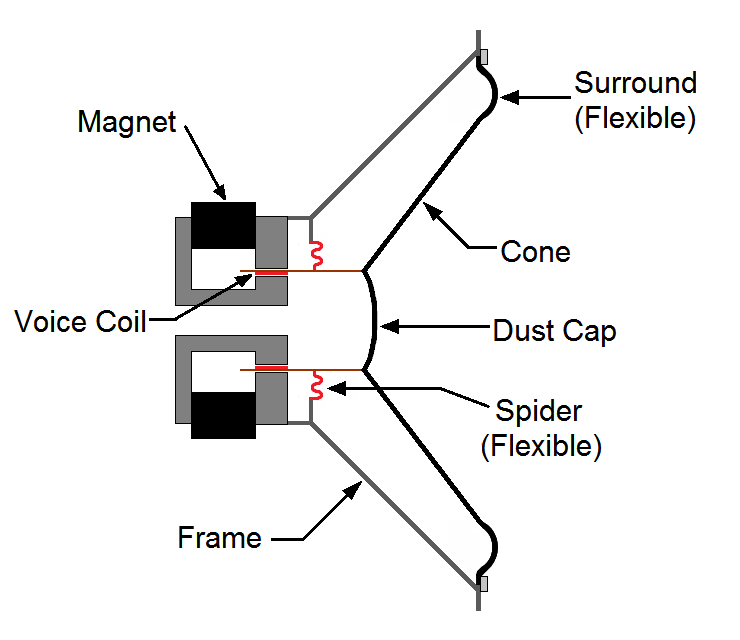
Diagram
moving-coil cartridge (MC) – a type of magnetic phonograph cartridge.
moving-coil headphones – see dynamic headphones.
moving-coil loudspeaker – a type of loudspeaker that uses a speaker cone (a lightweight diaphragm made of paper, plastic, or other material) that is attached to a frame (called a basket) with a flexible suspension so that the voice coil moves axially through a cylindrical magnetic gap. An electrical signal applied to the voice coil creates a magnetic field that generates a mechanical force causing the coil and the attached cone to move back and forth creating sound in accordance with the signal coming from the amplifier. The moving-coil loudspeaker was patented by Chester W. Rice and Edward W. Kellogg in 1924. See diagram. Moving-coil loudspeakers are the most common type of speaker. Also called a dynamic loudspeaker or cone loudspeaker.
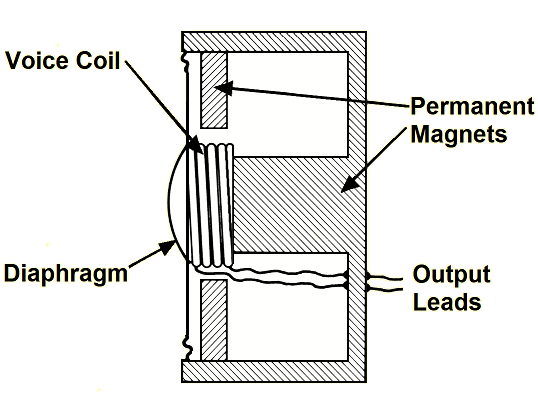
Diagram
moving-coil microphone – a type of dynamic microphone in which the diaphragm moves a coil in a fixed magnetic field to generate an electrical signal.
moving-magnet cartridge (MM) – a type of magnetic phonograph cartridge.
moving picture – see motion picture.
Moving Picture Experts Group (MPEG) – a subgroup within SMPTE that establishes various standards and specifications for audio and video applications, such as specifications for data compression methods for audio and video transmission.
moving fader – see motorized fader.
moving fader automation – a feature that allows an engineer to program audio levels that upon playback cause motorized faders on the mixer or console to move according to the programming.
MP – Metal Particle or Metal Particulate. See metal particle tape.
.mp+ – file extension for the Musepack format.
MP1 – see MPEG-1 Audio Layer I.
MP2 – see MPEG-1 Audio Layer II.
MP3 – short for MPEG-1 Audio Layer III. A file format for digital compression of an audio file, that reduces the size of the file significantly. Layer III is one of three coding schemes defined in the MPEG-1 Audio sdtandard. Layer III uses perceptual audio coding and psychoacoustic compression to remove superfluous information—redundant and irrelevant parts of a sound signal that the human ear does not hear. Layer III also has a frequency resolution that is 18 times greater than that of Layer II. This allows shrinking the size of an audio file by a factor of 12. It has been stated, that AAC produces the same quality audio at 96 kbps as does MP3 at 128 kbps, but with improvements in MP3 codecs (especially LAME), MP3s have performed comparable to AAC in some listening tests.
.mp3 – file extension for the MP3 format.
MP3 player – a small portable consumer electronic device that stores and plays music files in the MP3 format. MP3 players are in the broader category of digital audio players and often can play other file types, such as AAC and WMA.
MP3 Surround – an audio file format that adds surround sound capabilities to ordinary MP3 files. MP3 Surround files are backward-compatible, so they can be played by any MP3 player, but the surround sound information is only decoded by devices that support the format.
MP4 – MPEG-4 Part 14. A digital multimedia format standard specified as a part of MPEG-4, most commonly used to store video and audio, but can also be used to store other data. It is a container format that can be streamed over the internet. The official filename extension for MPEG-4 Part 14 files is .mp4, but several other extensions are used, such as .m4a and .m4p. Apple uses .m4a for audio only files that are usually compressed using lossy AAC encoding, but can also use the Apple Lossless Audio Codec (ALAC). Files with the .m4p extension use DRM protection technology to restrict copying.
.mp4 – file extension for the MP4 format.
.mpc – file extension for the Musepack format.
MPE – MIDI Polyphonic Expression or Multidimensional Polyphonic Expression.
MPEG – Moving Picture Experts Group.
MPEG-1 – an international standard established by MPEG as the codec used for video CD and CD-i media.
MPEG-1 Audio – an audio standard adopted by MPEG in 1992, that included three audio encoding techniques called layers. They have become known as Layer I (MP1), Layer II (MP2), and Layer III (MP3). They were formalized as ISO/IEC 11172-3. In 1995, these audio standards were expanded in MPEG-2, providing for additional bit rates and additional channels up to 5.1 multichannel, and formalized in ISO/IEC 13818-3.
MPEG-1 Audio Layer I (MP1) – one of three audio formats included in the MPEG-1 Audio standard. It is a simplified version of MPEG-1 Audio Layer II (MP2) designed to be used where lower quality audio is acceptable. Although it is supported by many media players, the codec is mostly obsolete, having been replaced by MP2 or MP3. Sometimes shown as MPEG-1 Audio Layer 1.
MPEG-1 Audio Layer II (MP2) – one of three audio formats included in the MPEG-1 Audio standard. It is primarily used in audio broadcasting. Sometimes shown as MPEG-1 Audio Layer 2.
MPEG-1 Audio Layer III (MP3) – one of three audio formats included in the MPEG-1 Audio Audio standard. See MP3. Sometimes shown as MPEG-1 Audio Layer 3.
MPEG-2 – an international standard established by MPEG for the digital compression of broadcast-quality, full-motion video. MPEG-2 is used for digital TV broadcast and DVD. The advanced audio coding (AAC) is a part of this specification.
MPEG-3 – a group of audio and video coding standards established by MPEG for use with HDTV. In 1992 HDTV was included as a separate profile in the MPEG-2 standard and MPEG-3 was rolled into MPEG-2.
MPEG-4 – a group of standards established by MPEG defining digital compression of digital audio and video data. It is used for transmission of internat audio-visual material (streaming media), voice data (telephone and videophone), and broadcast television applications.
MPEG-4 ALS – MPEG-4 Audio Lossless Coding. It is part of the MPEG-4 audio standard for lossless audio compression. It uses a method similar to FLAC to improve the quality of the audio reproduction.
MPEG-4 DST – MPEG-4 Direct Stream Transfer. It is part of the MPEG-4 audio standard for lossless audio coding of oversampled audio. It is also part of the Super Audio CD specifications.
MPEG-4 SLS – MPEG-4 Scalable to Lossless. It is part of the MPEG-4 audio standard that allows for lossless audio compression scalable to lossy MPEG-4 general audio coding methods, such as variations of AAC. MPEG-4 SLS can have both a lossy layer and a lossless correction layer similar to WavPack, but can also be formatted without a lossy layer.
MPEG-4 Structured Audio – a part of the MPEG-4 audio standard that provides for a powerful and flexible description of sound in a variety of ways, which are termed “structured audio.” This method transmits sound by describing it rather than compressing it. The sound descriptions generate audio when compiled (or interpreted) by the appropriate decoder. MPEG-4 Structured Audio consists of the following major elements: (1) Structured Audio Orchestra Language (SAOL), an audio programming language. (2) Structured Audio Score Language (SASL), used to describe the manner in which the algorithms in SAOL are used to produce sound. (3) Structured Audio Sample Bank Format (SASBF), which provides for the transmission of banks of audio samples to be used in wavetable synthesis. (4) BIFS (Binary Format for Scene Description), used to describe how objects in a structured media scene fit together. (5) Structured Audio Scheduler, the supervisory run-time element of the Structured Audio decoding process. (6) MIDI support, which provides backward-compatibility with existing content. See also advanced audio coding.
MPEG-DASH – see Dynamic Adaptive Streaming over HTTP (DASH).
MPEG-H – a series of standards developed by the ISO/IEC Moving Picture Experts Group (MPEG). These standards consist of MPEG-H Parts 1 through 13 and include specifications for a digital containers, audio compression, video compression, and testing procedures. Also known as ISO/IEC 23008: High efficiency coding and media delivery in heterogeneous environments.
MPEG-H 3D Audio – MPEG-H Part 3. One of the MPEG-H standards for coding 3D Audio, specifying audio channels, audio objects, and higher-order ambisonics (HOA). It also supports binaural rendering of sound for headphone listening.
mpg – one of a several file extensions for files encoded using MPEG-1 or MPEG-2 audio and video compression.
MPG – Music Producers Guild.
MPGA – Music Producers Guild of the Americas.
.mpp – file extension for the Musepack format.
MPPA – Music Publishers' Protective Association. See National Music Publishers' Association.
MPSE – Motion Picture Sound Editors. An honorary society of motion picture sound editors founded in 1953. The goals of the society include educating the public and the filmmaking community about the artistic merit of sound editing, showing the artistic merit of soundtracks, and improving the professional relationship of its members. Each year the MPSE presents the Golden Reel Awards in honor or the year's best work in the various areas of sound editing: dialog, ADR, sound effects, foley, and soundtrack music.
MPX – (1) Abbreviation for multiplex, the process for broadcasting stereo on analog FM radio. (2) A button marked “MPX” on some cassette decks, that activates a 19-kHz notch filter to FM stereo pilot tone so that does not intefere with Dolby noise reduction systems. The Dolby decoding system can mistakenly sense the pilot tone as high-frequency content in the music. It can also cause audible birdies if beating with the tape bias occurs.
MQA – Master Quality Authenticated.
MQA, Ltd. – a company based in Huntingdon, UK, and spun off from Meridian Audio in 2015, for the purpose of promoting and licensing Master Quality Authenticated (MQA).
MRSS – Music Recording Studio Security. See Music Recording Studio Security Program.
MRSSP – Music Recording Studio Security Program.
ms – abbreviation for milliseconds.
MS, M/S, M-S, or M&S – Mid-Side or Mono-Stereo. See mid-side.
MSM – Mid-Side-Mid. See double mid-side.
MSO – Multiple-System Operator. A company that operates multiple cable or direct-broadcast satellite television systems. The Federal Communications Commission (FCC) defines a cable company as a facility that serves a single community or a specific governmental entity. Although a cable company that serves multiple communities can be considered an MSO, the term is usually used for companies that own a large number of suxh systems. See also MVPD.
MST – see master session (MST).
MTC – MIDI Time Code.
MTM – Midrange-Tweeter-Midrange.
MTR – MultiTrack Recording.
MTS – Multichannel Television Sound. The format for stereo sound used with standard definition television broadcasts prior to the adoption of HDTV. It also permitted a third channel called SAP (Separate Audio Program), which was used for alternate languages or other purposes.
mu – (1) The amplification factor or gain of a triode vacuum tube. (2) The Greek letter μ.
muddy – (1) A descriptive term for a sound that is unclear or lacking definition due to excesses in the mud range, having excessive reverberation or leakage. The opposite of clear. (2) A descriptive term for a mix in which various instruments are overlapping each other in frequency.
mud range – slang for the audio frequencies between 200 Hz and 400 Hz (the lower midrange). Excessive boosting in this range can overwhelm the higher frequencies causing a muddy, undefined sound. Sometimes called the cardboard frequencies.
mufex – short for music and effects. See M&E.
muffled – a descriptive term for a sound with weak upper midrange to high frequency range, similar to blanketed.
muffler – see silencer.
mu law – see μ-Law.
multi – short for multicore cable. See snake.
multicore cable – see snake.
multiband compressor – a type of compressor that allows the user to select specific frequency bands and acts on them independently. Sometimes called a split-band compressor.
multiband processor – a processor that allows the user to select specific frequency bands upon which the processor will act. Probably the most used of these is the multiband compressor.
multiblock – see power strip.
multichannel – (1) Having or using many audio channels, especially more than the usual two stereo channels. (2) Sometimes used a reference to surround sound. (3) Capable of delivering more than one television channel, such as cable operators, direct-broadcast satellite services, and multichannel multipoint distribution services
Multichannel Broadcast Wave Format (MBWF) – see RF64.
multichannel identification tone – see BLITS.
multichannel multipoint distribution service (MMDS) – a method of providing a wireless cable television programming or general-purpose broadband networking useing microwave frequencies in the 2.5 GHz to 2.7 GHz range, which is received via rooftop microwave antennas. Formerly known as Broadband Radio Service (BRS) and also called wireless cable.
Multi-Dimensional Audio (MDA) – an open and license-free multichannel immersive audio format developed by DTS that uses audio objects along with metadata that renders sound positions. The format allows content creators to create one program that can be played with any playback configuration, without the need for producing multiple output formats.
Multidimensional Polyphonic Expression. – see MIDI Polyphonic Expression.
multieffects pedal – an effects pedal for instruments that creates two or more effects simultaneously so that one device can replace several single-purpose units. These devices usually use digital processing to simulate the effects. Such devices often can be programmed, having several memory locations to save custom user settings.
multieffects processor – a signal processor that can perform more than one processing function. Also called a multiprocessor.
multi-lane – see playlist.
multimedia – (1) The combining of several media, such as audio and full-motion video in computer applications. (2) Pertaining to, or involving the use of multimedia.
multimode filter – a filter that can function in two or more modes, such as low-pass, high-pass, and band-pass modes. Most modern filter plug-ins have this capability.
multi-mono – a format used by Pro Tools which allows a plug-in to affect each side of a stereo signal separately. When the multichannel version is used, the plug-in makes identical changes to both sides.
multing – creating two or more tracks so that they can be processed in different ways. On a console, the signal would be routed to two or more channels. This also can be accomplished using a patchbay or a Y connector. In a digital audio workstation, you can create duplicate tracks or use two or more aux tracks with different processing.
multipath interference – when a radio signal reaches an antenna via more than one path, causing phase cancellation that results in signal loss and dropouts. A number of systems have been created to counteract this problem. Sometimes called multipath reflections. See diversity, antenna diversity, and true diversity.
multipath relections – see multipath interference.
multipattern microphone – see switchable-pattern microphone.
multiple-D microphone – a type of directional microphone with minimal proximity effect due to multiple sound pathlengths between the front and rear entry points.
multiplex – (1) The process for broadcasting stereophonic sound on analog FM radio. Abbreviated MPX. (2) A system providing for the simultaneous transmission of several signals on a single channel of communication. (3) To combine a video and audio signal into one file containing both video and audio. Called mux for short.
multiprocessor – see multieffects processor.
multisampling – see keygrouping.
multisession – a format for a compact disc or CD-ROM in which the digital information is recorded at two or more separate times (sessions).
multi-stage compression – using more than one compressor on an audio signal in either parallel or series. For example, one common approach on vocals is to use an UREI 1176 FET-style compressor followed by a Teletronix LA2A-style compressor. The 1176 tames the transients while the LA2A imparts a smooth and natural character. Other examples of multi-stage compression include vocal tone compression, rear bus compression, and Brauerizing. Multi-stage compression should not be confused with multi-band compression. See also parallel compression.
multitap delay – a digital delay that has multiple outputs (taps), each with different delay times and amplitudes.
multitimbral – the ability of a synthesizer to reproduce more than one pitch or timbre at the same time.
multitrack – (1) Having the ability, either through hardware or software, to record or play back more than one track or channel. In particular, a multitrack should be able to provide for monitoring one or more tracks while recording on one or more other tracks. (2) A wide-format audio recording tape on which parallel tracks can be recorded, each containing a performance by one or more instrumentalists, vocalists, or virtual tracks. (3) To use a wide-format audio recording tape to record several performances, either at once or individually.
multitracking – see multitrack recording.
multitrack recorder – a machine or device that can be used to record and play back more than one track or channel of audio signals. A multitrack recorder usually has the ability to monitor one or more tracks while recording on one or more other tracks.
multitrack recording (MTR) – recording several separate audio signals onto different channels (tracks) of a recording medium. Multitrack recording began in 1955 when engineers began to record different audio signals onto separate discrete tracks on the same reel-to-reel recording tape. Multitrack recording allowed various instruments and vocals of a song to be recorded separately, either simultaneously or at different times, which allowed them to be mixed together at a later time. Prior to this development, all of the singers and musicians had to sing and play together at the same time. Multitrack recording allows the engineer to adjust the levels and effects on each track individually, to make overdubs, to layer several takes, and, if necessary, to redo (punch in) certain tracks or parts of a track to correct errors or to obtain a better take. Today, multitrack recording can be performed digitally. Also known as multitracking.
multitrack tape formats – various analog recording tape formats used with reel-to-reel and cassette tape machines for multitrack recording. These formats are summarized in the chart below. See also 2-track, 3-track, 4-track, 8-track, 16-track, 24-track, and 32-track.
| Tracks | Tape Width | Format | Tape Speed (ips) |
|---|---|---|---|
| 2 | ¼-inch | Open Reel/Stereo | 7.5 - 15 |
| 2 | ½-inch | Open Reel/Stereo | 7.5 - 30 |
| 3 | ¼-inch | Open Reel/Stereo | 7.5 - 15 |
| 4 | ¼-inch | Open Reel/Stereo | 3.75 - 7.5 |
| 4 | ⅛-inch | Cassette/Stereo | 1⅞ |
| 4 | ⅛-inch | Cassette/Multitrack | 3.75 |
| 4 | ¼-inch | Open Reel/Multitrack | 7.5 - 15 |
| 4 | ½-inch | Open Reel/Multitrack | 7.5 - 30 |
| 8 | ¼-inch | Open Reel/Multitrack | 7.5 - 15 |
| 8 | ½-inch | Open Reel/Multitrack | 7.5 - 30 |
| 16 | ½-inch | Open Reel/Multitrack | 7.5 - 30 |
| 16 | 1-inch | Open Reel/Multitrack | 15 - 30 |
| 24 | 1-inch | Open Reel/Multitrack | 15 - 30 |
| 24 | 2-inch | Open Reel/Multitrack | 15 - 30 |
| 32 | 2-inch | Open Reel/Multitrack | 15 - 30 |
Muscle Shoals Sound Studio – a recording studio located in Muscle Shoals, Alabama, founded in 1969 by four session musicians that made up the Muscle Shoals Rhythm Section (known as the Swampers). They left Rick Hall's nearby FAME Studios in Muscle Shoals to form their own recording facility. In 1979, they moved to a new location, which operated as a recording studio until 2005. In 2006 the original location was listed on the National Register of Historic Places. It was partially restored in the early 2000s. In 2013 it was sold to the Muscle Shoals Music Foundation, which completed the restoration. It reopened in 2017 as a recording studio and for tours.
Musepack (MPC) – an open source lossy audio codec designed for high quality audio that has been compressed at bit rates of 160 to 180 kbit/s, but can go up to 320 kbit/s. Formerly known as MPEGplus, MPEG+, or MP+, it uses the .mpc, .mp+, .mpp file extensions.
music – (1) An artistic form of sonic communication using rhythms and tones in a structured and continuous manner. (2) The music industry.
MUSIC – a holding company headquartered in Makati City, Metro Manila, Philippines, and chaired by Uli Behringer, founder of Behringer. It was formerly known as the Music Group. Besides Behringer, which was founded in 1989, in Willich, Germany, the company also owns other audio companies such as Midas, Klark Teknik, Eurotec, Turbosound company, and TC Group (consisting of TC Electronic, TC-Helicon, TC Applied Technologies, Tannoy, Lab Gruppen, and Lake). Much of its manufacturing is done at its plant in Zhongshan, China. Research and development and marketing activities are conducted at MUSIC's Manchester, UK offices.
musical – (1) Related to or pertaining to music or the production of music. (2) Having the nature or resemblance to music. Being melodious or harmonious. (3) Being skilled in music. (4) A play or motion picture in which the story line or dialog is interspersed with and often developed using songs and dances.
musical architecture – see musical form.
musical comedy – see musical, definition #4.
musical composition – (1) An original piece of music that has a melody, but may or may not have lyrics. Music with lyrics is called a song, while one without lyrics is called an instrumental or by the somewhat ambiguous term instrumental song. The term is often used in copyright law to distinguish the music from the sound recording. (2) The structure of a musical piece. (3) The process of creating or writing a new song or piece of music. People who create new compositions are called composers (especially for orchestral and classical music) or songwriters (especially for popular music and traditional music). The person who writes the words for a song is called the lyricist.
musical form – the overall structure of a piece of music or the arrangement of its various sections, such verse, chorus, and bridge. The form is often indicated using capital letters, such as ABA, AABA, ABCA, etc., to indicate the order of these sections. One of the most common forms is intro, verse, pre-chorus, chorus, verse, pre-chorus, chorus, bridge, verse, chorus, and outro. Also called musical architecture, song form, or song structure.
musical instrument – see instrument.
musical key – see key.
musical notation – see music notation.
musical scale – see scale.
musical score – see score.
Musicassette (MC) – see cassette.
music bed – music in the background of a voice over.
MusicBrainz – a project that endeavors to create an open content music database similar to the freedb project. It was founded in response to the restrictions placed on the CDDB by Gracenote, Inc. MusicBrainz goes beyond maintaining a compact disc database to be an open online database for all music. The database contains as a minimum the album title, track titles, and the length of each track, but can also include release date and country, cover art, acoustic fingerprint, additional text, and other metadata. Using software that communicates with MusicBrainz, metadata tags can be added to digital audio file, such as MP3, Ogg Vorbis, AAC, etc. These entries are maintained by volunteer editors using written style guidelines.
music business – see music industry.
Music Center Incorporated (MCI) – a manufacturer of recording studio consoles, multitrack recorders, and other pro audio equipment, established in Fort Lauderdale, Florida in 1965. In 1982, it was acquired by the Sony Corporation.
music clearance – the process of obtaining the necessary permissions to use specific pre-existing pieces of music in a motion picture. Also called rights clearance.
music group – see ensemble.
Music Group – see MUSIC.
musician – (1) A person who plays a musical instrument, especially one who does it as a profession. (2) A person who is skilled in music.
music industry (MI) – companies and individuals involved in the production, promotion, distribution, and sale of music and musical instruments, including live musical performances. It includes singers, songwriters, composers, musicians, conductors, bandleaders, music publishers, producers, recording studios, engineers, record labels, retail music stores, performance rights organizations, booking agents, promoters, music venues, and road crews, talent managers, A & R managers, business managers, entertainment lawyers, radio stations (online and broadcast), TV stations, music journalists, music critics, music educators, musical instrument manufacturers, and many others. It is sometimes broken down into six main groups: (a) musical instruments, (b) recording, (c) song writing/composing, (d) publishing, (e) live music, and (f) artist managment.
music key – see key.
Music Loudness Alliance (MLA) – an industry group consisting of audio technical and production experts that strives to inform and educate the audio community on loudness normalization and ways to combat the “loudness war.”
music notation – a method of writing or visually representing music, using a variety of symbols that represent notes as well as the duration, loudness, and other factors that affect the notes. Also called musical notation.
music notation software – see score editor.
music notation processor – see score editor.

music note – (1) A symbol used in musical notation to represent the relative duration and pitch of a sound. (2) A single musical sound at a specific pitch (frequency). Also called a tone. See chart showing notes and their frequencies, as well as the corresponding MIDI note number.
music note value – see note value.
music player – see media player.
Music Producers Guild (MPG) – an professional organization, headquartered in London, UK, that promotes and represents individuals in the music production and recording professions, and that embodies the collective and individual creative contributions to the production and recording of all genres of music and media related activities. The MPG annually presents the Music Producers Guild Awards to recognize the talent and ability of producers, engineers, mixers, and remixers. Membership is open to all producers, engineers, mixers, re-mixers, programmers, sound designers, mastering engineers, students, enthusiasts—anyone interested in the creation of music and audio.
Music Producers Guild of the Americas (MPGA) – formerly the professional organization for music producers and audio recording engineers. However, it was merged with the Recording Academy in 2000 as the Producers and Engineers Wing.
music publisher – see publisher.
Music Recording Studio Security (MRSS) – see Music Recording Studio Security Program.
Music Recording Studio Security Program (MRSSP) – a program jointly developed by operational and technical specialists within the recording industry and administered by the CDSA to establish music recording studio security (MRSS), a set of security controls to measure the effectiveness of recording studios or individuals involved in the recording studio process in securing and protecting physical and digital media. The program focuses on the access to and handling of such media to mitigate the risk and reduce the impact of copyright infringement resulting from leaked content. An organization or individual can be certified if it passes the required criteria of CDSA auditors.
music score – see score.
music scoring – composing music used in a movie, television program, or play.
music staff – see staff.
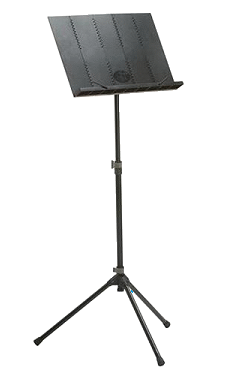
music stand – a pedestal with a rack or frame, usually made of wood or metal, used to hold sheet music in position for reading by a musician.
music technology – using technology, such as tools, machines, computers, and software, in the creation, performance, composition, recording, and playback of music.
music theorist – a person who studies music theory.
music theory – the field of study dealing with the concepts and mechanics of music and how music works. Music theory analyzes and presents the elements of music, such as rhythm, harmony, melody, structure, form, and texture. Some theorists study the patterns inherent in the techniques used by various composers.
music tracker – see tracker.
Musikmesse – a trade show held annually in Frankfort Germany, featuring musical instruments, lighting, sound reinforcement, and recording equipment. See also NAMM.

(b) Straight Mute
(c) Cup Mute
mute – (1) To turn off or silence the audio signal from a channel on a console or DAW. Sometimes called cut. (2) The button or control used to silence an audio signal. (3) To damp the strings of a stringed instrument by placing the side of the hand or the edge of the palm over the strings close to the bridge (called palming or palm muting or using the fretting hand to damp the strings while strumming with the other producing a percussive sound (called fret hand muting. (4) A clamp placed over the bridge of a stringed instrument to reduce resonance without changing the vibration of the strings. (5) A hollow, cone-shaped device that fits into the bell of a brass instrument, creating a metallic, sometimes nasal sound, that can result in a very piercing note. Called a straight mute. (6) A round cup-shaped device placed over the bell of a brass instrument which removes the upper and lower frequencies creating a rounder, more muffled tone. Also called a cup mute.
mute button – the button or control used to silence (mute) an audio signal. Also called a mute switch or cut switch.
muted note – see ghost note.
muted strumming – a guitar playing technique using the fretting hand (the left hand for most people) to damp or mute the strings of an instrument while strumming with the other, producing a percussive sound with no ringing of the strings. Some people say muted strumming is synonymous with fret-hand muting, but others say the term implies continuous strumming rather than an occasional mute.
mute switch – see mute button.
mute track with CPU-saving preference selected – see disable.
mutual angle – see axis angle.
Mutual Broadcasting System, Inc. (MBS) – a US radio network operated from 1934 to 1999. From 1934 to 1952, Mutual was owned and operated as a cooperative (similar to the way NPR operates today), in which member stations shared their original programming, expenses, and revenues. This business structure ended when General Tire assumed majority ownership in 1952 through a series of radio station acquisitions. In 1957, Mutual was purchased by a group headed by Armand Hammer, but a year later was sold to the Scranton Corporation. Mutual was soon taken into bankruptcy. Because of its financial difficulties, Mutual never successfully entered the television network businsess. In 1960, the network was revitalized when it was purchased by the 3M Company. In 1966, 3M sold the network to a privately held company, Mutual Industries, Inc., and the network was renamed to the Mutual Broadcasting Corporation. The network was purchased by Amway in 1977. In 1985, the network was acquired by Westwood One, a major radio production company and syndicator. In 1987, Westwood One purchased its long-time competitor, the NBC Radio Network. Westwood One was acquired by Infinity Broadcasting in 1994. In 1996, Westinghouse, the new parent company of CBS, purchased Infinity. In effect, the direct descendants of the three original US radio networks had merged. In early 1999, Westwood One dropped the Mutual name and became CNN Radio. Also known as the Mutual Broadcasting Company, Mutual Radio Network, Mutual Radio, or simply Mutual.
mux – short for multiplex.
MVPD – Multichannel Video Programming Distributor. Cable operators, direct-broadcast satellite services, multichannel multipoint distribution services, and other multichannel television providers. See also MSO.
Mylar® – DuPont's trade mark for an extraordinarily strong polyester film that was developed in the early 1950s. Mylar with its superior tensile strength, heat resistance, and excellent insulating properties, became the standard base for magnetic recording tape used for both audio and video. It is also used to manufacure some drumheads. Mylar is often used as a generic term for any polyester film. Mylar is now a product of the joint venture DuPont Teijin Films.
MXF – Material eXchange Format.
MXL – the pro audio division of Marshall Electronics, a privately owned company headquartered in Torrance, CA, specializing in industrial and consumer electronics. Marshall Electronics was founded in 1980 by Leonard Marshall, an electrical engineer. MXL (located in El Segundo, CA) introduced its first microphone inj 1998 with the goal designing and manufacturing a condenser microphone at an affordable price that could rival the performance of much pricier microphones.
Note: We believe this is the largest dictionary (glossary) of terms specific to usage within the recording industry that is currently available on the internet, with more than 8,800 entries, nearly 800 illustrations, and dozens of tables. Some of the terms have different or additional meanings in other situations, especially within the electronic, automotive, scientific, and computer industries. Of necessity there are obvious overlaps into other fields such as music, electronics, and computers, but such excursions are limited to information deemed pertinent to the knowledge required to operate and/or participate effectively in the workings of a recording studio. Also included are terms related to sound reinforcement (live performances) including wireless microphone technology because a working knowledge of that terminology is necessary for recording at live performance venues. Because recording studios also record audio for video and motion pictures (films), some terminology from those fields is included. Some scientific terms are included because they help explain studio terminology. For example, electromagnetism explains how microphones, loudspeakers, and guitar pickups work. Knowledge of radio waves and the radio frequency spectrum is needed to explain wireless devices. Any trademarks or trade names mentioned belong to their respective owners. The information contained in this dictionary is believed to be accurate at the time of publication. This information is subject to change without notice. The information was obtained from and cross-checked with a variety of sources that are believed to be reliable. However, Los Senderos Studio, LLC does not guarantee the accuracy or completeness of the information contained herein. Please contact us to report any errors, omissions, discrepancies, or broken links. Los Senderos Studio shall not be responsible for any consequences or damages arising out of the use of this information. Nothing in this glossary should be interpreted as legal advice. For a glossary providing information on legal and business matters for musicians, we suggest you consult Musicians Business Dictionary.
A note on alphabetical order: The terms in this glossary are alphabetical without regard to spaces and punctuation. For example, AM Radio follows amplitude. While this may seem to be at odds with other conventions, it eliminates confusion with words such as pickup, which is sometimes written as pick up or pick-up. In addition, all symbols such as &, -, or / are ignored. The entries on the number page (0-9) are listed in increasing value within each digit. For example, all of the entries beginning with 1 are listed before those starting with 2. For Greek letters (α-ω), the entries are in Greek alphabetical order.


